Coastal kitchens embody the relaxed, airy essence of beachfront living through carefully chosen design elements that evoke the sea, sand, and sky. These spaces prioritize natural light, soothing color palettes, and organic materials that create a timeless aesthetic. Whether you're designing a beach house or bringing coastal vibes to an urban home, the right combination of colors, textures, and finishes can transform any kitchen into a tranquil seaside sanctuary. Modern coastal design has evolved beyond literal nautical themes, embracing sophisticated approaches that balance comfort with elegance.
1. Coastal Kitchen with White Shaker Cabinets and Navy Blue Island
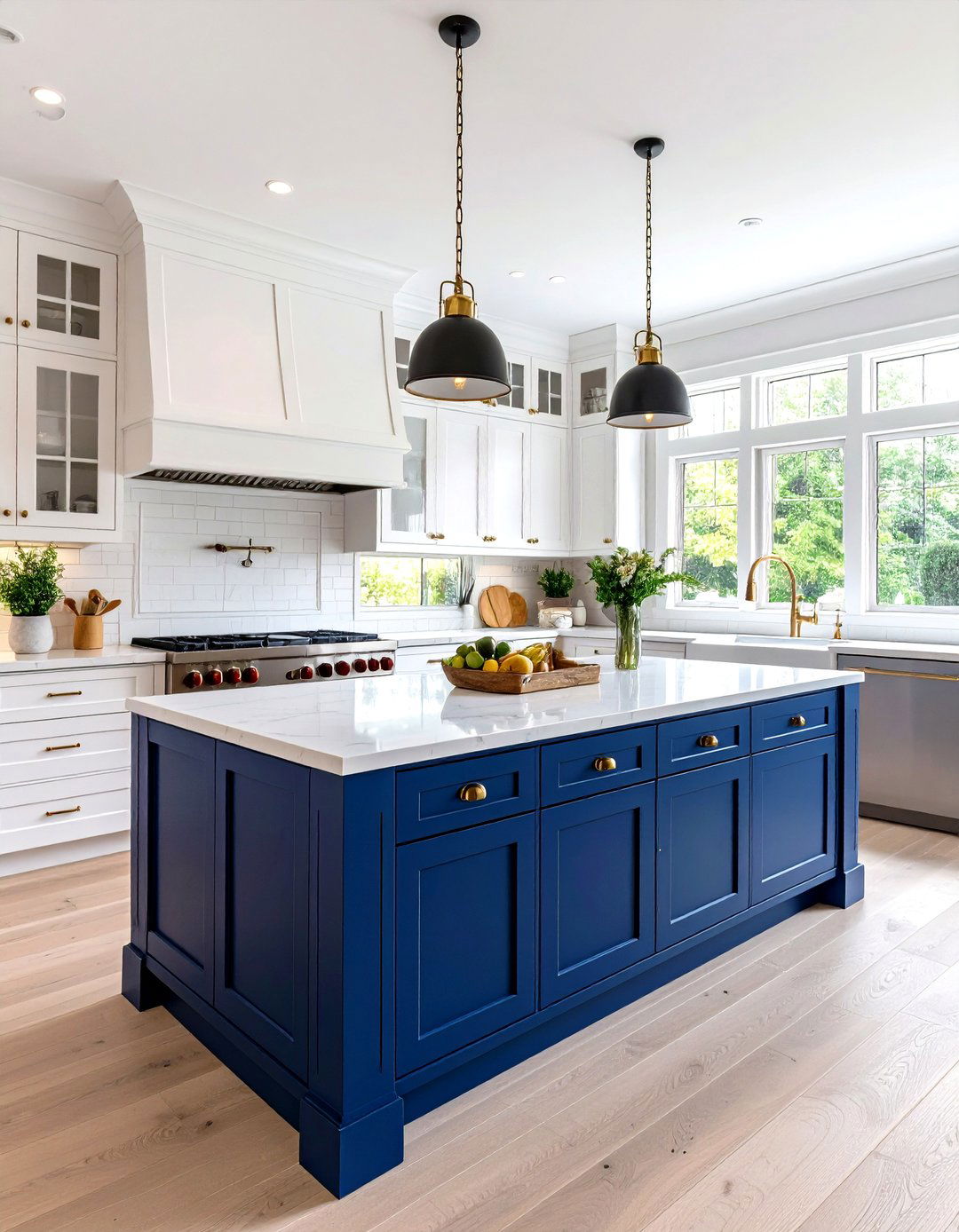
Transform your space with the timeless combination of crisp white shaker cabinets paired with a statement navy blue island. This classic coastal color scheme creates stunning visual contrast while maintaining the bright, airy feel essential to seaside design. The white cabinets reflect natural light and make the space feel larger, while the navy island serves as a sophisticated focal point that anchors the room. Consider adding brass hardware to warm up the cool tones and create visual interest. This combination works beautifully with both traditional and contemporary coastal styles, offering versatility that will remain fresh for years to come. The deep blue evokes ocean depths while maintaining enough neutrality to pair with various accent colors and seasonal decorative elements.
2. Coastal Kitchen with Glass Tile Backsplash in Ocean Blues
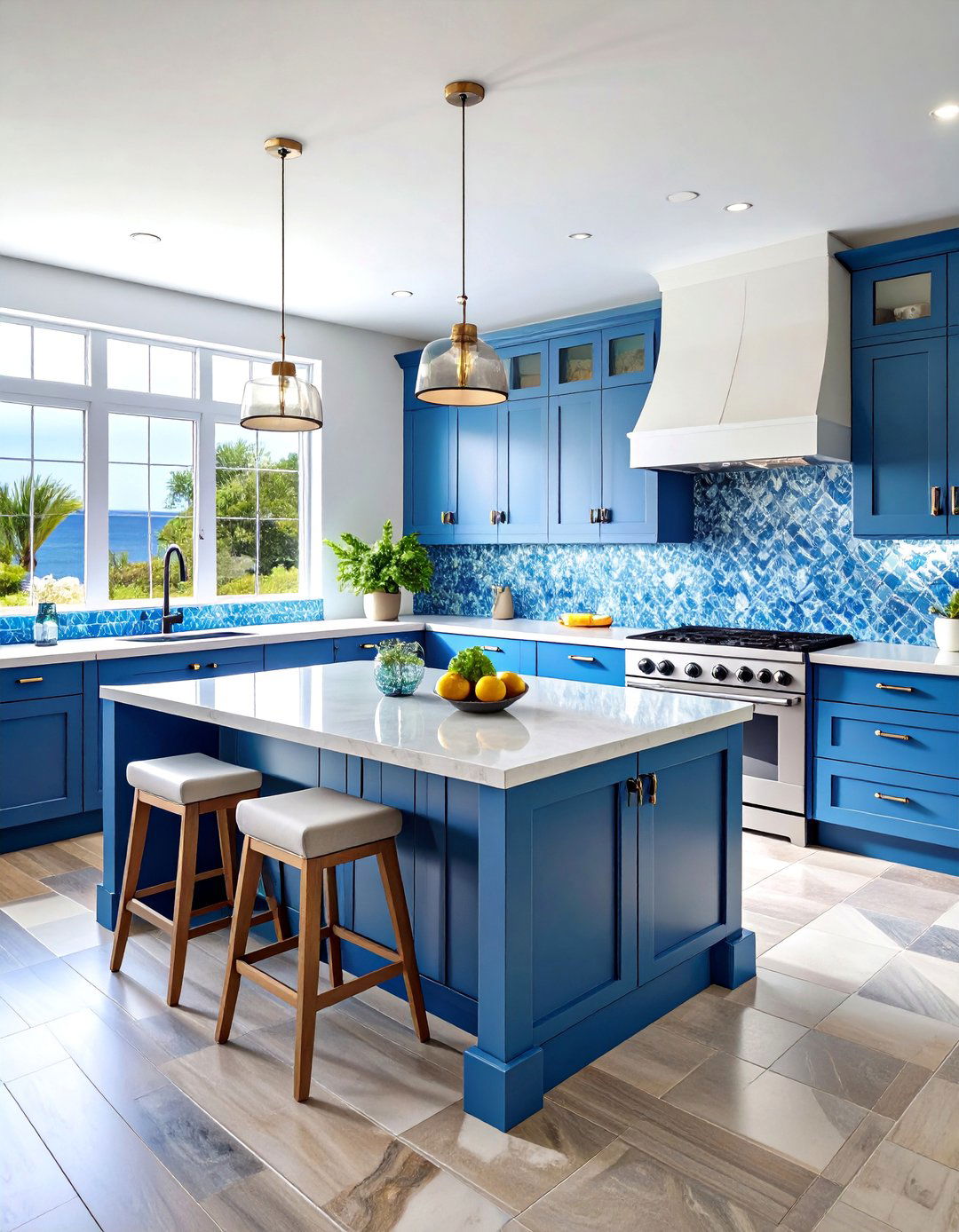
Create mesmerizing visual depth with a glass tile backsplash featuring varying shades of ocean blue. These tiles mimic the natural movement and color variations found in coastal waters, with light and dark blue tones that shift beautifully throughout the day. Glass tiles reflect light naturally, enhancing the bright, open feeling crucial to coastal design while adding a subtle shimmer reminiscent of sunlight dancing on water. The reflective quality of glass creates an almost iridescent effect that brings the beauty of the sea indoors. Choose tiles in a subway or mosaic pattern for classic appeal, or opt for larger format glass tiles for a more contemporary look. This backsplash option pairs beautifully with white or light-colored cabinetry and natural stone countertops.
3. Coastal Kitchen with Rope and Wicker Pendant Lighting

Illuminate your coastal kitchen with natural fiber pendant lights that bring organic texture and seaside charm overhead. Rope and wicker fixtures capture the essence of maritime adventures while providing functional task lighting over islands and dining areas. These materials add warmth and visual interest to the space while maintaining the relaxed, casual atmosphere essential to coastal design. Look for fixtures crafted from jute rope, natural rattan, or woven seagrass that create beautiful patterns of light and shadow on surfaces below. The organic shapes and textures of these pendant lights soften the hard lines of cabinetry and countertops. Choose oversized statement pieces for dramatic impact or cluster smaller fixtures for layered lighting that enhances the room's ambient glow.
4. Coastal Kitchen with Whitewashed Wood Plank Flooring
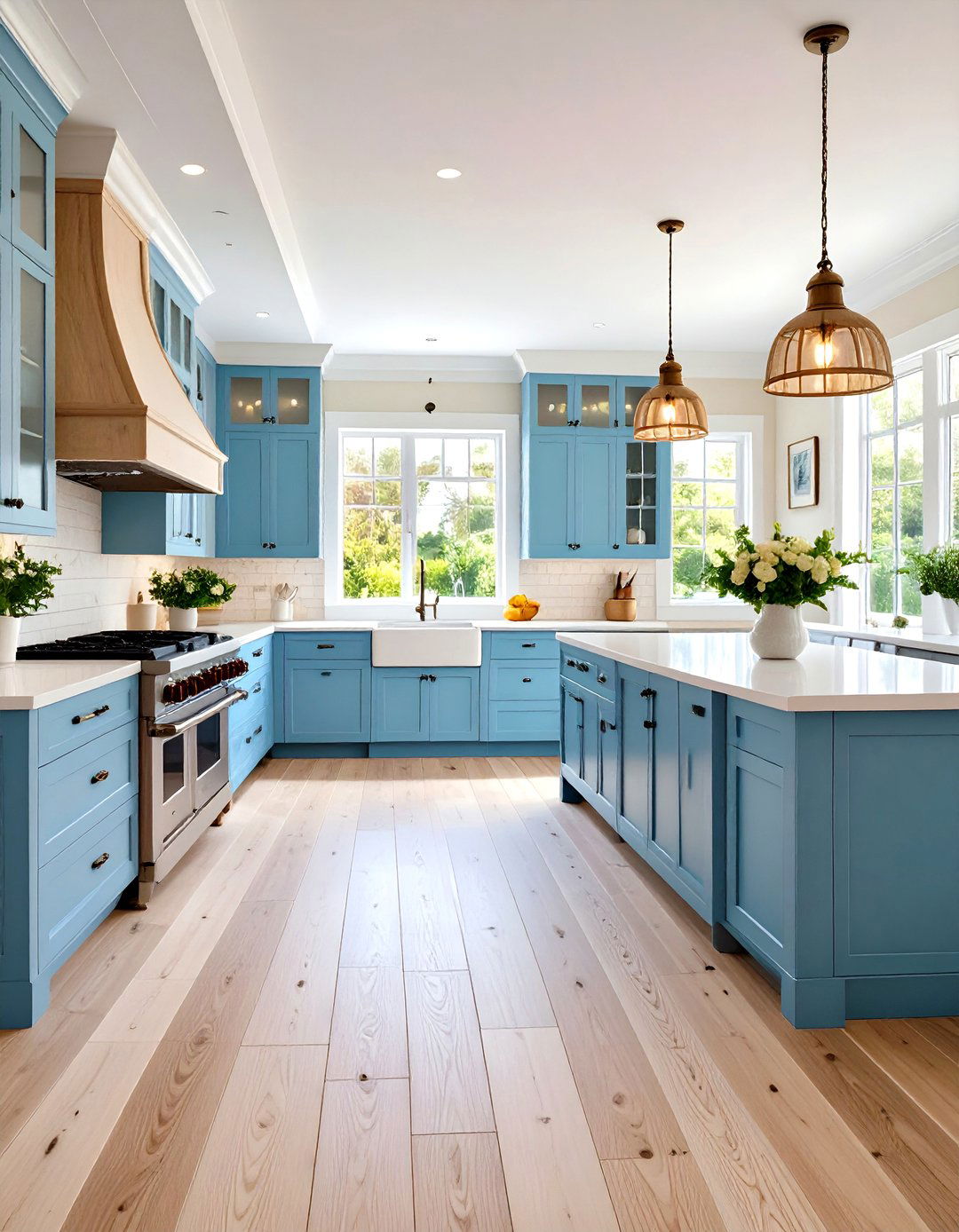
Establish the perfect foundation with whitewashed wood plank flooring that evokes weathered boardwalks and driftwood. Light-colored wood floors create the bright, airy atmosphere fundamental to coastal design while adding natural warmth and texture. The whitewashed finish provides a clean, fresh backdrop that makes the space feel larger and more open. Consider luxury vinyl plank options that offer the authentic wood appearance with superior water resistance and durability essential for kitchen environments. Wide planks enhance the sense of space and flow, while the pale tones complement both neutral and colorful accent pieces. This flooring choice pairs beautifully with white cabinetry and natural materials, creating a cohesive coastal aesthetic that feels both polished and relaxed.
5. Coastal Kitchen with Subway Tile and Shiplap Walls

Embrace classic coastal architecture with white subway tile backsplashes and shiplap wall treatments. White subway tile offers affordable, timeless appeal while creating clean lines that enhance the kitchen's bright, crisp appearance. Shiplap walls throughout the space bring to mind boardwalks and beaches while adding texture and visual interest. This combination creates a cohesive backdrop that allows other design elements to shine while maintaining the relaxed, cottage-like atmosphere essential to coastal style. The horizontal lines of shiplap help expand the visual width of the space, while subway tile's rectangular format provides pleasing proportional balance. Consider installing subway tile in a classic running bond or modern stacked pattern for different aesthetic effects that complement your overall design vision.
6. Coastal Kitchen with Seafoam Green Cabinet Accents
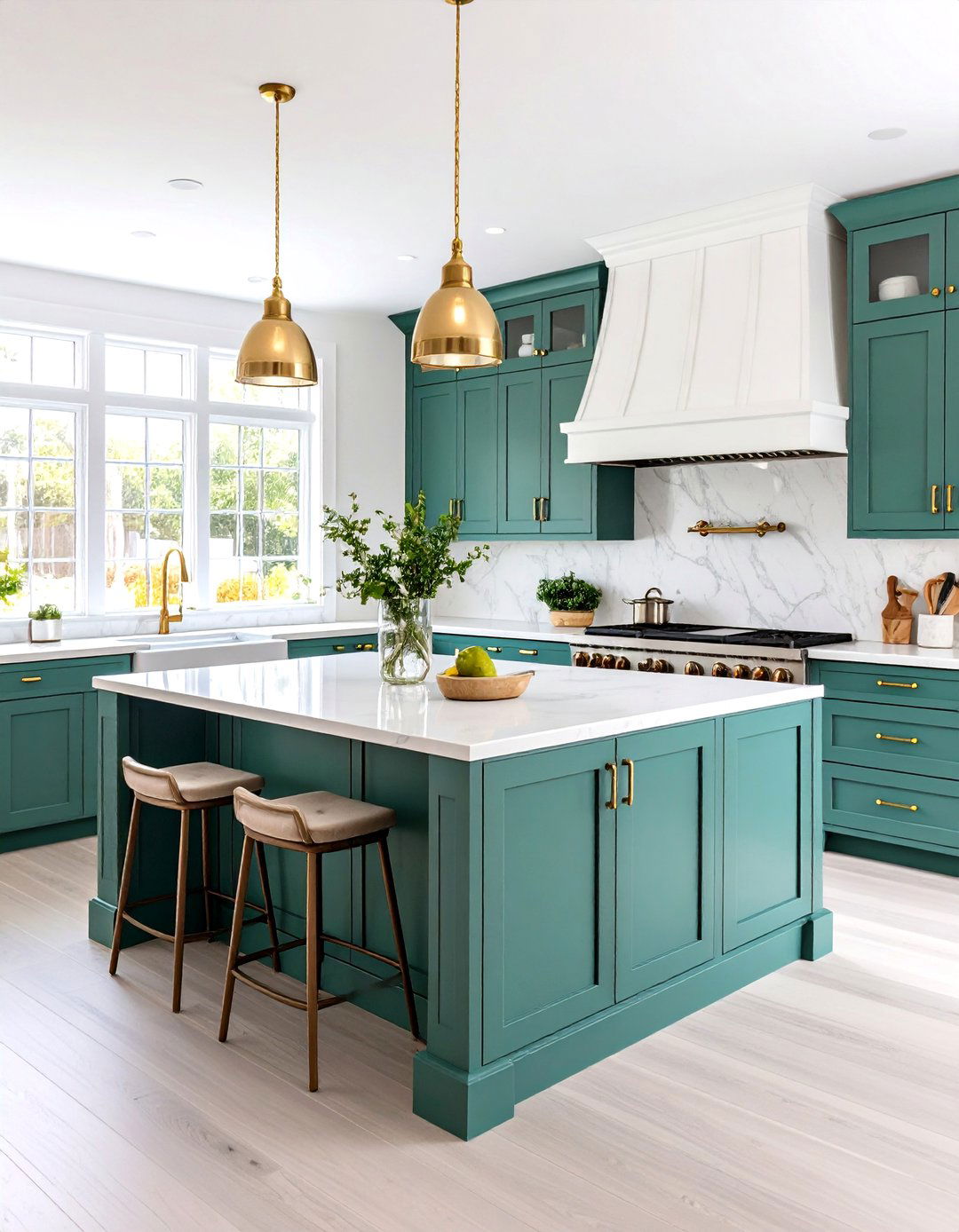
Introduce subtle coastal color with seafoam green cabinet accents that capture the gentle hues of shallow tidal pools. Seafoam green provides a refreshing pop of color while maintaining the serene, calming atmosphere essential to coastal design. Use this soft blue-green shade on lower cabinets, an island, or select upper cabinets to create visual interest without overwhelming the space. This color pairs beautifully with white cabinetry and natural wood elements, creating a sophisticated yet relaxed coastal palette. The gentle hue works particularly well in kitchens with abundant natural light, where it can shift subtly throughout the day. Consider complementing seafoam green cabinets with brass or brushed gold hardware to add warmth and prevent the space from feeling too cool or clinical.
7. Coastal Kitchen with Natural Wood Open Shelving

Replace upper cabinets with natural wood open shelving to create an airy, relaxed coastal atmosphere. Open shelving allows more light to flow through the space while providing opportunities to display beautiful dishware and coastal-inspired accessories. Choose reclaimed or weathered wood that adds character and reinforces the casual, beachy aesthetic. The natural wood tones bring warmth to predominantly white or light-colored kitchens while creating visual texture and depth. Display sea glass dishes, woven baskets, and natural materials that enhance the coastal theme without feeling overly decorated. Open shelving encourages a more organized, curated approach to kitchen storage while making the space feel larger and more open than traditional closed cabinetry would allow.
8. Coastal Kitchen with Marble Countertops and Brass Hardware
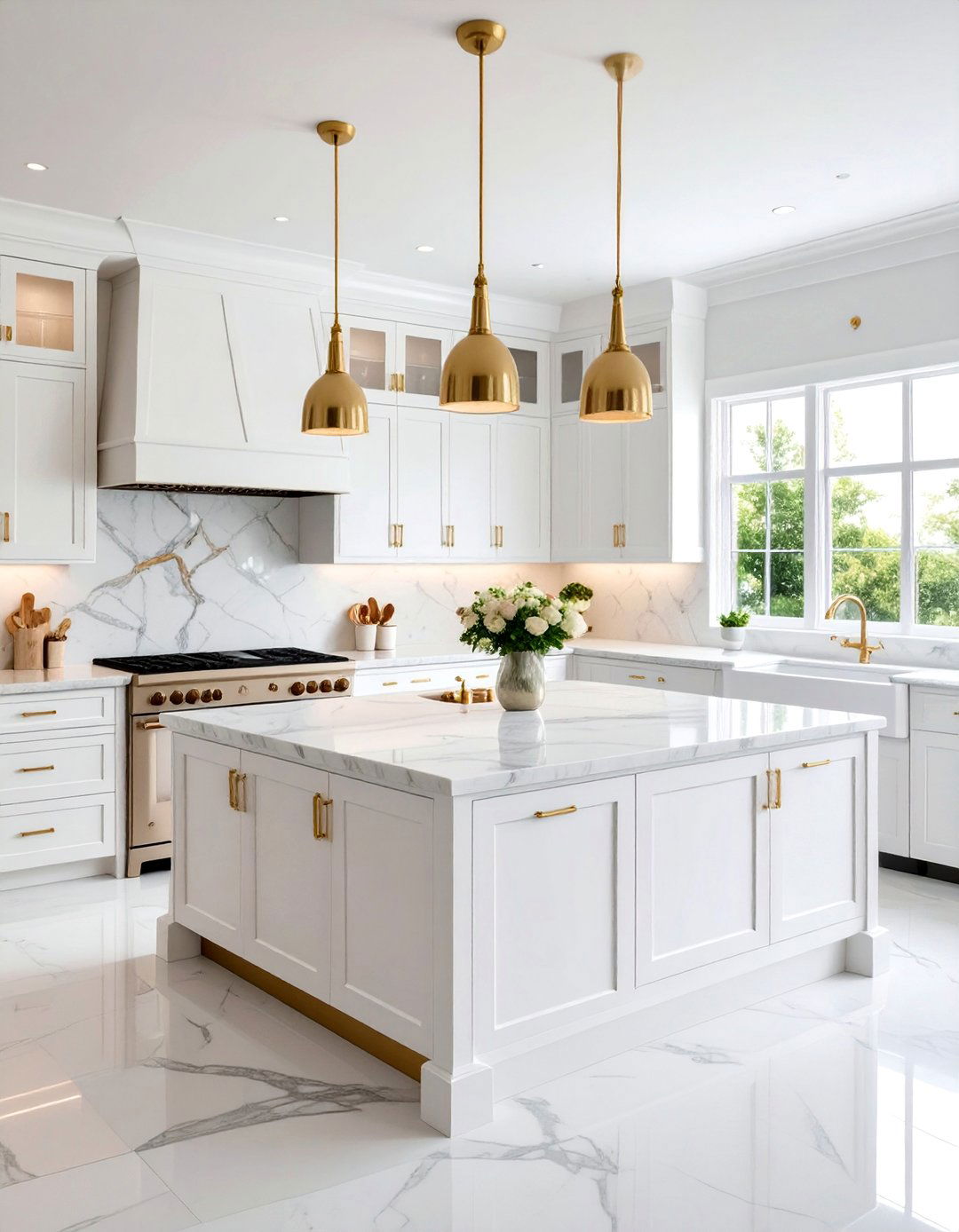
Elevate your coastal kitchen with natural marble countertops featuring subtle veining reminiscent of ocean waves. Marble's natural patterns and streaks resemble the ripples of the sea, making it an ideal choice for sophisticated coastal design. The stone's cool, smooth surface provides an elegant contrast to warm wood elements and brass hardware. Brass accents add warmth and sophistication while preventing the space from feeling too stark or clinical. Choose marble varieties with soft gray or blue veining to enhance the coastal color palette. Pair with white or light-colored cabinetry to let the marble's natural beauty take center stage. The combination of marble and brass creates a timeless, upscale coastal aesthetic that balances luxury with the relaxed, welcoming atmosphere essential to seaside living.
9. Coastal Kitchen with Fish Scale Tile Backsplash
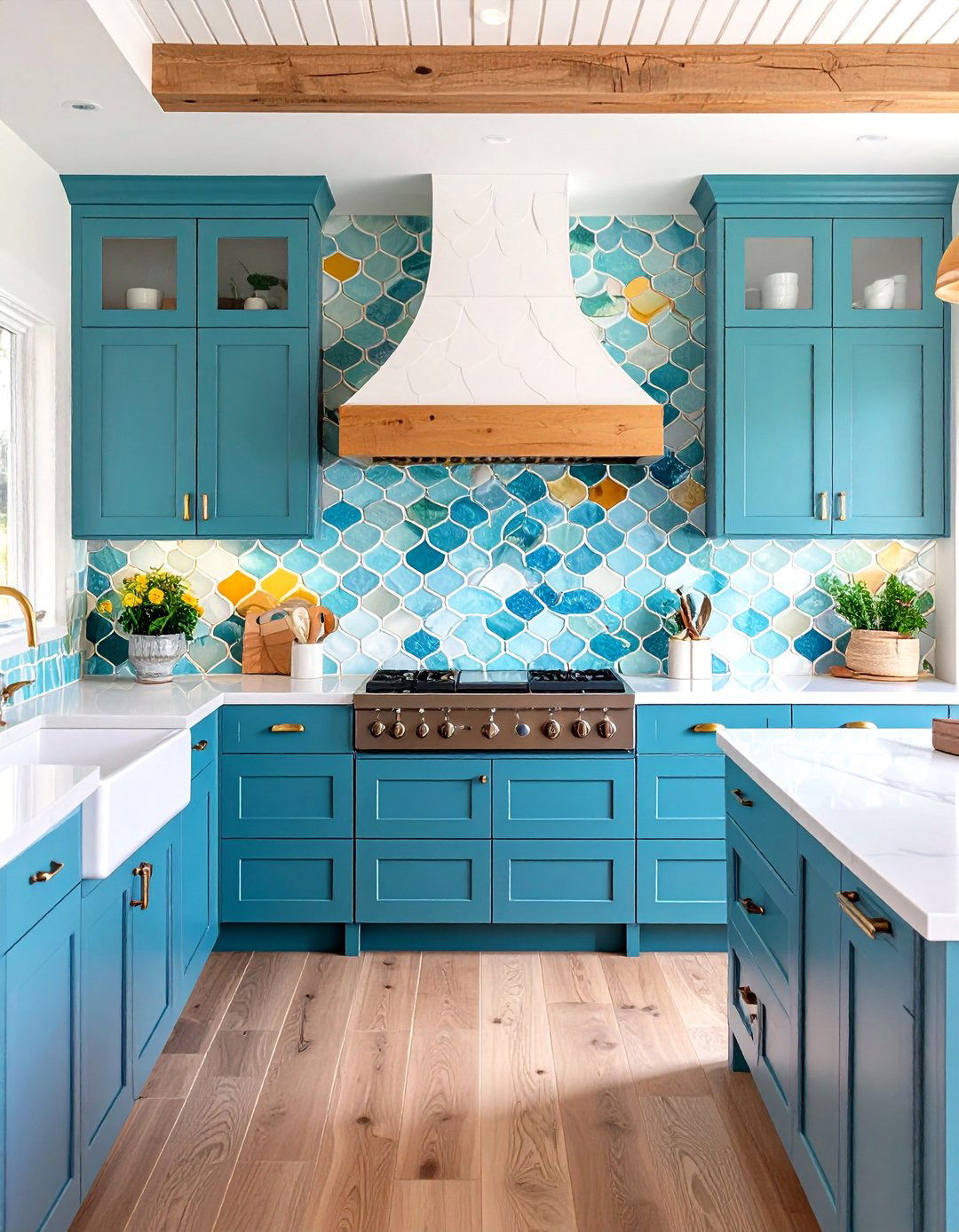
Create visual interest with fish scale or scallop tile backsplashes that subtly reference marine life. These uniquely shaped tiles add texture and movement to the wall while maintaining sophisticated coastal appeal. The overlapping scale pattern creates natural shadow lines that add depth and dimension to the backsplash area. Choose subtle colors like soft white, pale blue, or seafoam green to maintain the light, airy feeling essential to coastal design. Fish scale tiles work particularly well in well-lit kitchens where their dimensional quality can be fully appreciated. This distinctive tile shape pairs beautifully with simple shaker cabinets and natural materials, creating a sophisticated coastal look that feels both current and timeless. The organic pattern adds visual interest without overwhelming the space or competing with other design elements.
10. Coastal Kitchen with Two-Tone Blue and White Cabinets
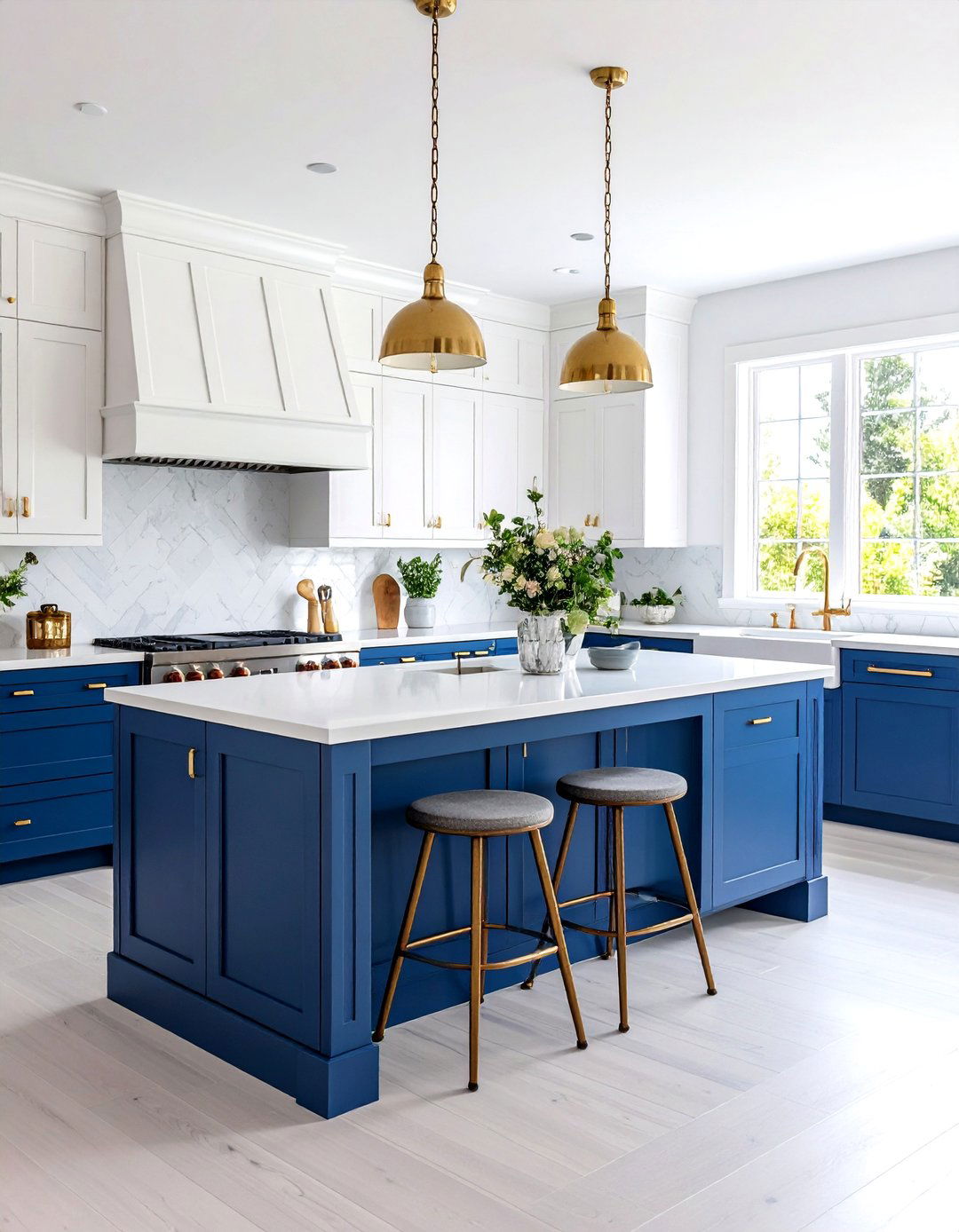
Design drama with two-tone cabinetry combining navy or blue-gray lower cabinets with crisp white uppers. This classic coastal color combination creates visual weight at the base while maintaining bright, airy upper areas that enhance the feeling of space. The darker lower cabinets help ground the design and hide wear from daily use, while white upper cabinets reflect light and make ceilings appear higher. This arrangement works particularly well with brass or gold hardware that warms up the cool color palette. Consider extending the blue tone to include the island for additional cohesion. The two-tone approach allows for greater flexibility in accent colors and seasonal decorating while maintaining the sophisticated, timeless appeal that makes coastal kitchens so enduringly popular.
11. Coastal Kitchen with Weathered Wood Beam Ceiling
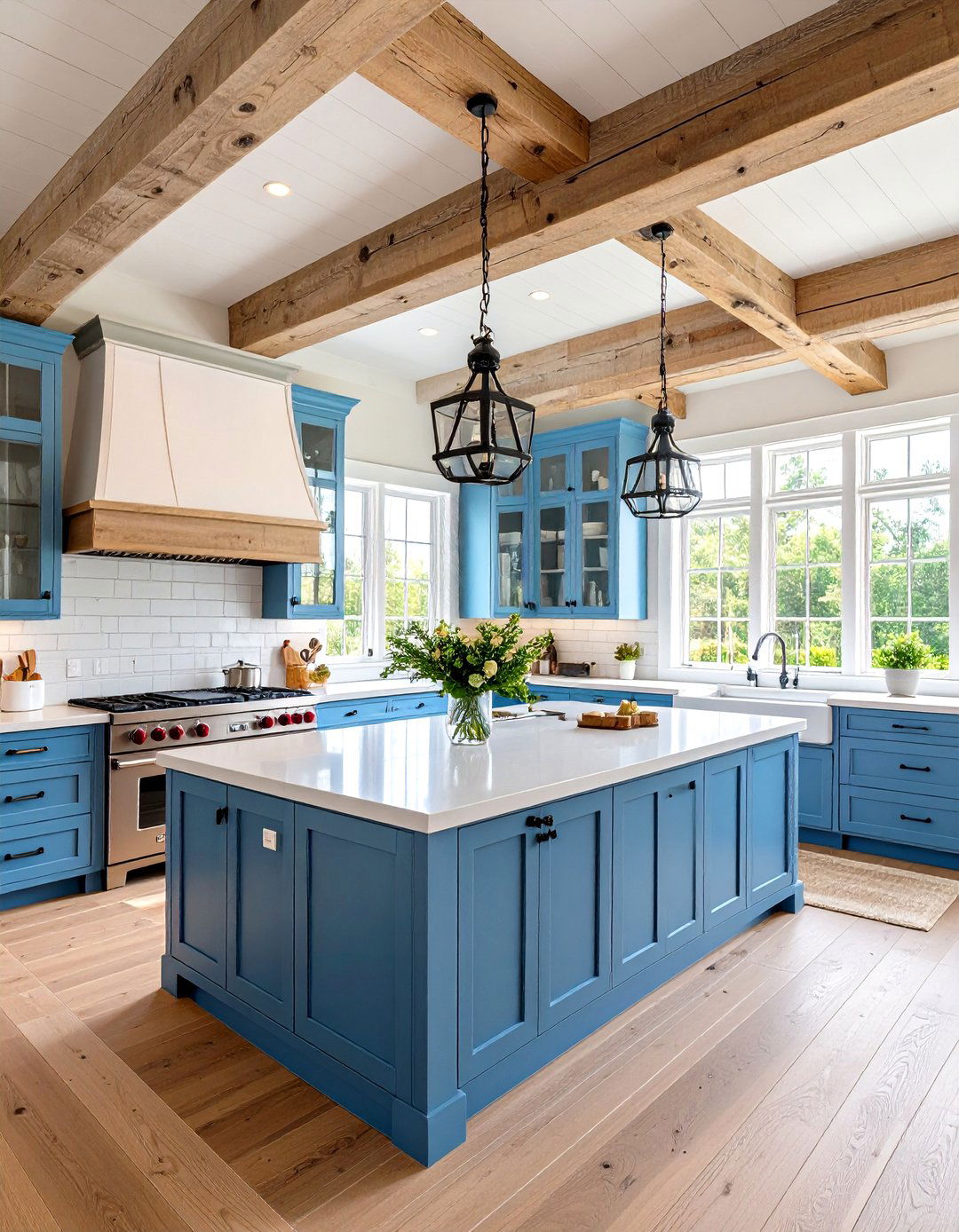
Add architectural character with exposed or faux weathered wood ceiling beams that reference coastal building traditions. Natural wood beams create visual interest overhead while adding warmth and texture to predominantly white or light-colored spaces. The rustic element balances polished surfaces and brings organic character to the room. Choose beams with weathered or driftwood finishes that complement the coastal aesthetic without feeling too rustic or overwhelming. Wood ceiling elements help tie together other natural materials throughout the space while creating cozy definition in open-concept layouts. The horizontal lines of ceiling beams can help expand the visual width of narrower kitchens while adding the kind of architectural detail that makes coastal spaces feel authentic and well-designed rather than themed or artificial.
12. Coastal Kitchen with Mosaic Shell Tile Accents
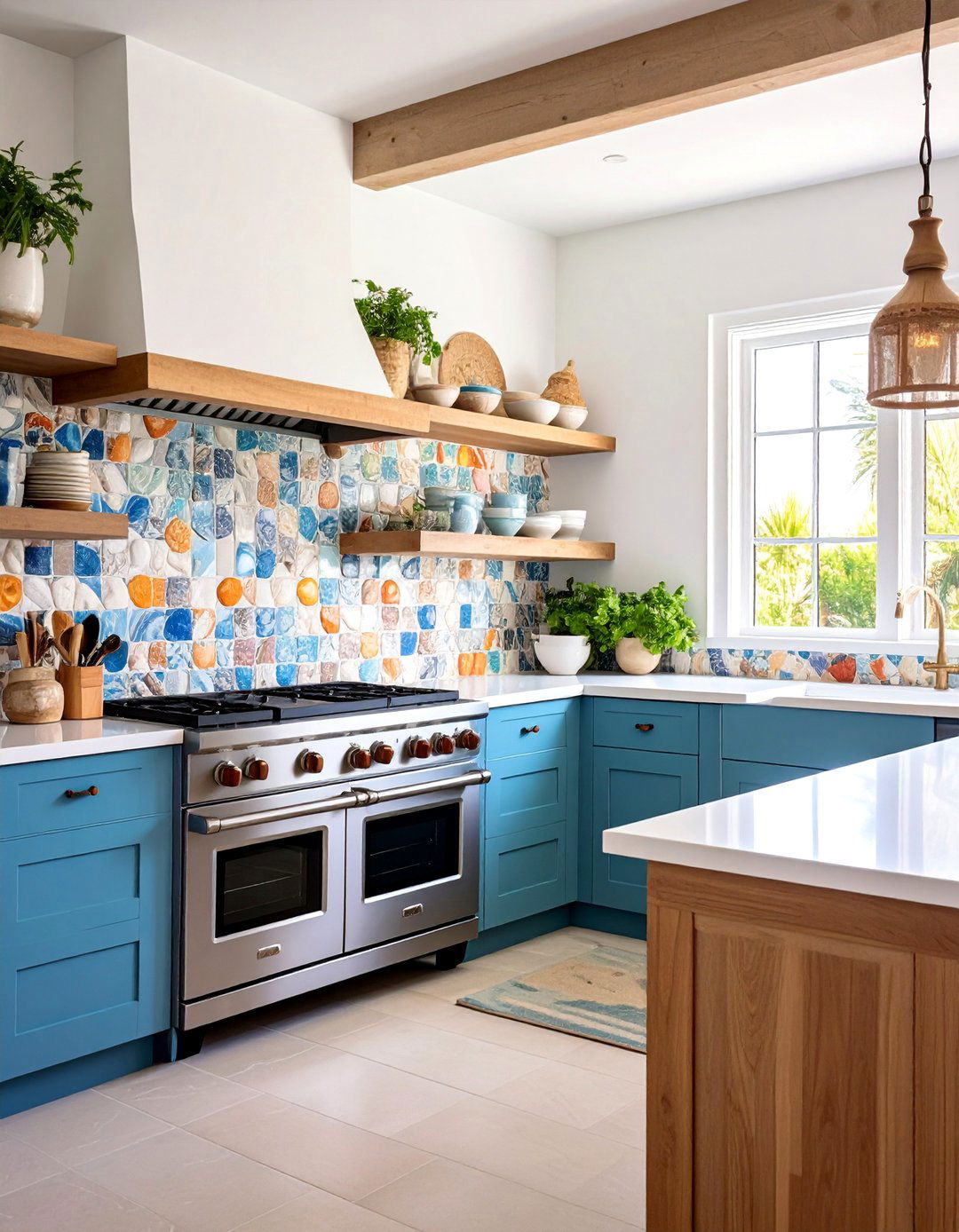
Incorporate authentic coastal elements with mosaic shell tiles used as accent features or backsplash details. Real shell mosaics reflect light beautifully while adding luxurious texture to the relaxed coastal aesthetic. Use these special tiles sparingly as border accents, behind open shelving, or in small featured areas to avoid overwhelming the space. The natural iridescence of shells creates subtle color shifts that change throughout the day as light conditions vary. Shell mosaic tiles work particularly well in smaller doses, adding coastal authenticity without becoming too literal or themed. Pair with neutral backgrounds like white subway tile or natural stone to let the shell details shine. This approach adds genuine coastal character while maintaining the sophisticated, elevated aesthetic that makes these kitchens feel custom and special rather than predictably beachy.
13. Coastal Kitchen with Rattan Bar Stools and Seating

Bring natural texture and casual comfort with rattan or wicker seating that enhances the relaxed coastal atmosphere. Natural fiber seating adds warmth and organic texture while maintaining the casual, comfortable feeling essential to coastal living. Choose bar stools with clean lines and neutral cushions to balance comfort with style. Rattan furniture pieces introduce the kind of natural materials that make coastal spaces feel authentic and welcoming. Consider counter-height stools for islands or dining-height chairs for breakfast nooks and casual eating areas. The natural color and texture of rattan complements wood tones while softening hard surfaces like stone and tile. This seating choice works particularly well with white or light-colored cabinetry, creating pleasing contrast while maintaining the airy, uncluttered feeling that defines successful coastal design.
14. Coastal Kitchen with Large Format Porcelain Stone Tiles
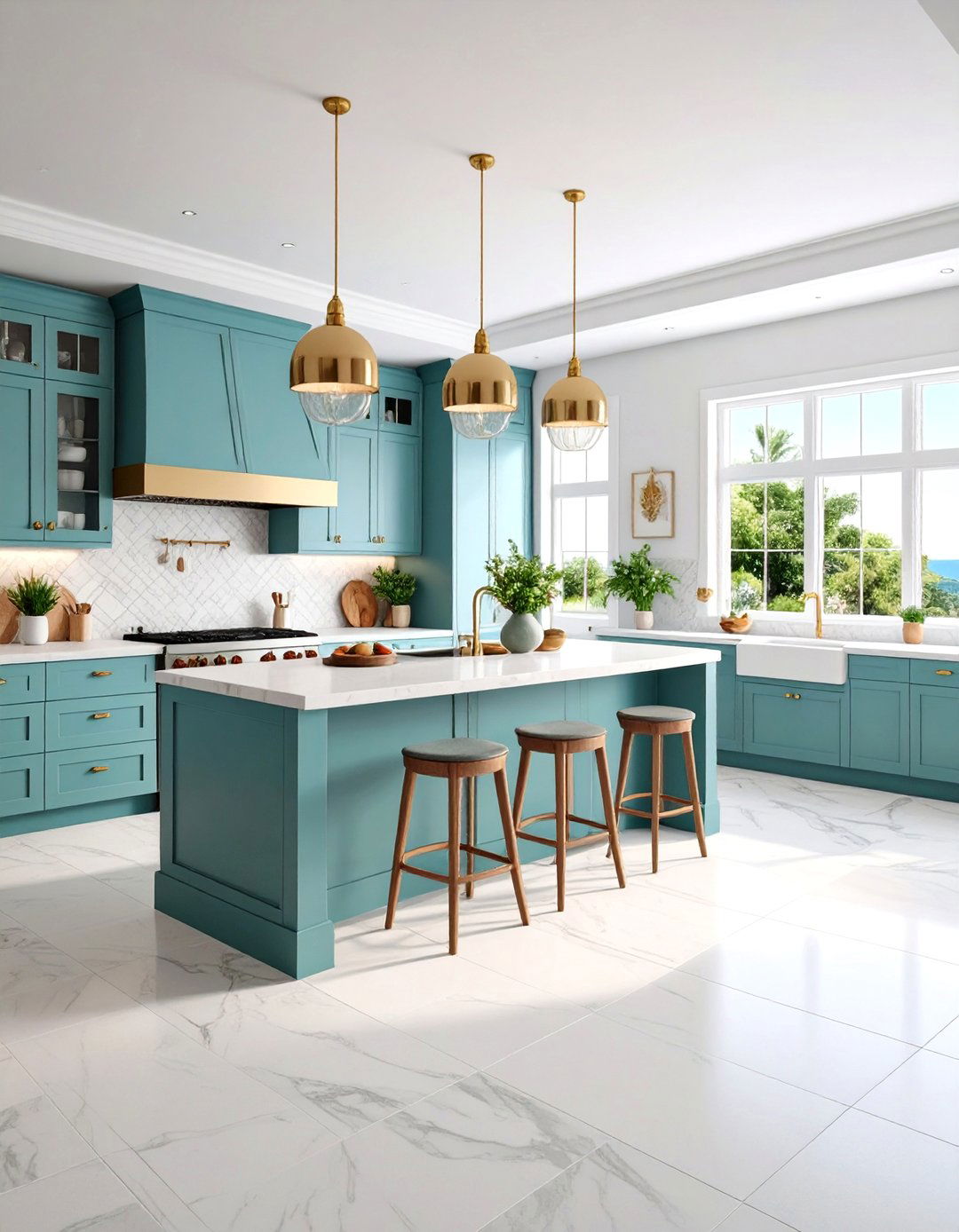
Create seamless, sophisticated flooring with large format porcelain tiles that mimic natural stone. Large tiles minimize grout lines for a cleaner, more contemporary look while providing the durability essential for kitchen environments. Choose neutral tones like soft gray, warm beige, or pale cream that complement coastal color palettes. Large format tiles are trending for their ability to make spaces feel larger and more cohesive. The stone-look finish adds natural texture without the maintenance requirements of genuine stone materials. These tiles work particularly well in open-concept spaces where consistent flooring helps unify different functional areas. Consider extending the same tile from interior spaces to covered outdoor areas for seamless indoor-outdoor flow that enhances the coastal lifestyle. The sophisticated, understated approach creates a perfect foundation for coastal design elements.
15. Coastal Kitchen with Sage Green Painted Cabinets
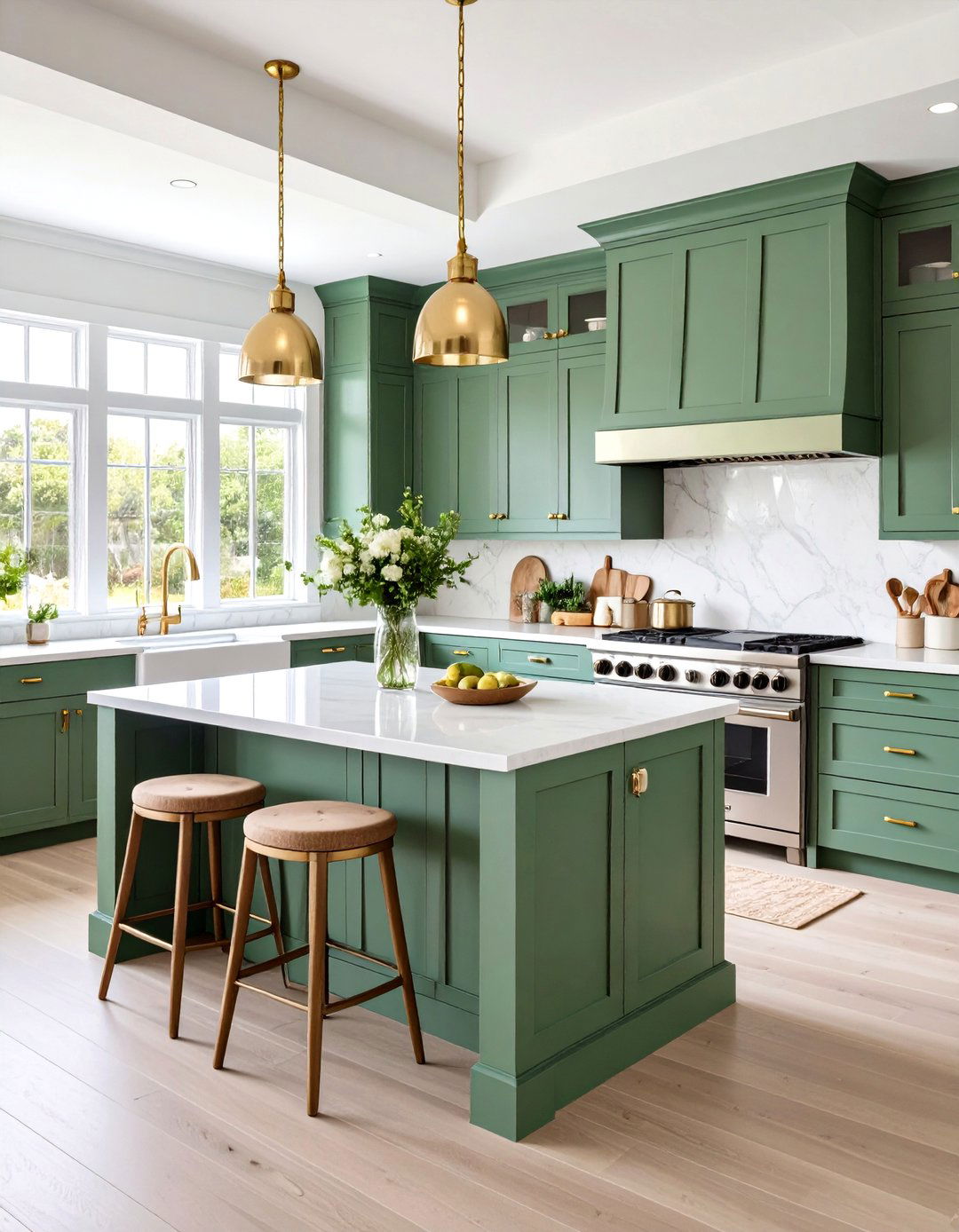
Embrace subtle coastal color with sage green cabinetry that brings the calming essence of sea grass and dune vegetation indoors. Sage green offers a sophisticated alternative to traditional blue tones while maintaining the soothing, natural feeling essential to coastal design. This muted green-gray works particularly well in kitchens with limited natural light, where it adds color without making the space feel dark or closed-in. Pair with white or cream countertops and brass hardware for warmth and sophistication. The earthy undertones of sage green complement natural wood elements and neutral stone finishes. This color choice works beautifully as an all-over cabinet treatment or as an accent on islands and lower cabinets paired with white uppers. The subtle, complex hue creates depth and interest while maintaining the serene atmosphere that makes coastal kitchens so appealing and relaxing.
16. Coastal Kitchen with Woven Grass Cloth Wallpaper

Add subtle texture and natural warmth with grass cloth wallpaper on accent walls or breakfast nook areas. The organic weave brings authentic coastal texture while maintaining sophisticated appeal that complements modern design elements. Natural fiber wallcoverings add depth and interest without overwhelming the space or competing with other coastal elements. Choose neutral tones like cream, soft beige, or pale sage that enhance rather than dominate the color palette. Grass cloth works particularly well in dining areas or as an accent behind open shelving where its texture can be appreciated up close. The natural material reinforces the connection to organic coastal elements while adding warmth to predominantly cool-toned spaces. Consider using grass cloth on a single feature wall to create focal interest without overwhelming the bright, airy feeling essential to coastal design aesthetics.
17. Coastal Kitchen with Driftwood-Style Floating Shelves
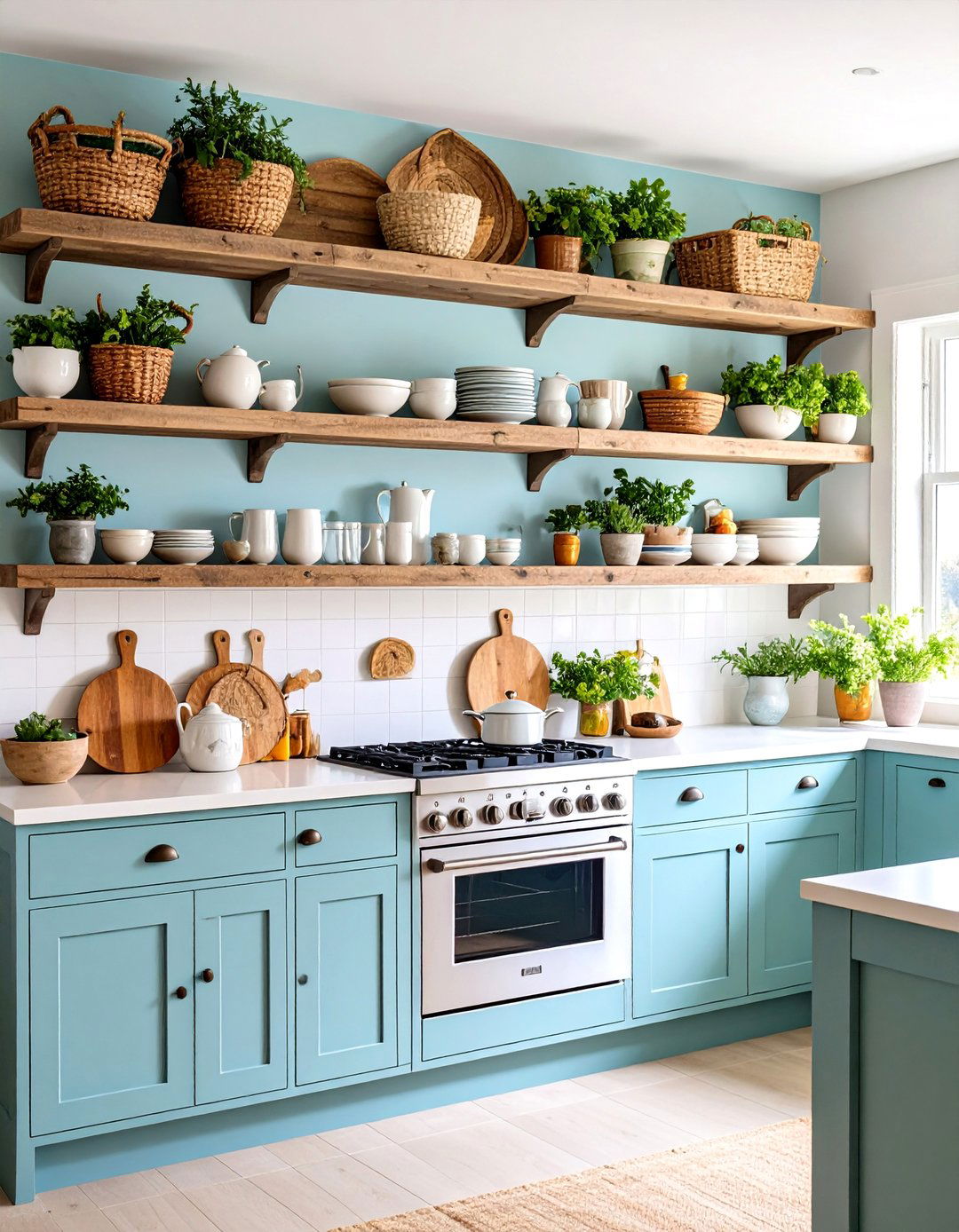
Install floating shelves with weathered, driftwood-inspired finishes that capture the essence of treasures washed ashore. These organic-looking shelves provide practical storage while adding authentic coastal character and natural texture. The irregular, weathered appearance of driftwood-style shelving creates visual interest against smooth wall surfaces while maintaining the casual, collected-over-time feeling essential to coastal style. Use these shelves to display everyday dishes, glassware, and coastal-inspired accessories that enhance the theme without feeling forced or overly decorated. Natural wood elements bring warmth to cool-toned coastal palettes while providing opportunities for curated displays. Choose shelves with subtle variations in tone and texture that suggest authentic weathering rather than obviously manufactured distressing. This approach adds personality and character while maintaining the sophisticated, elevated aesthetic that makes coastal kitchens feel custom and carefully designed.
18. Coastal Kitchen with Blue-Gray Quartz Countertops
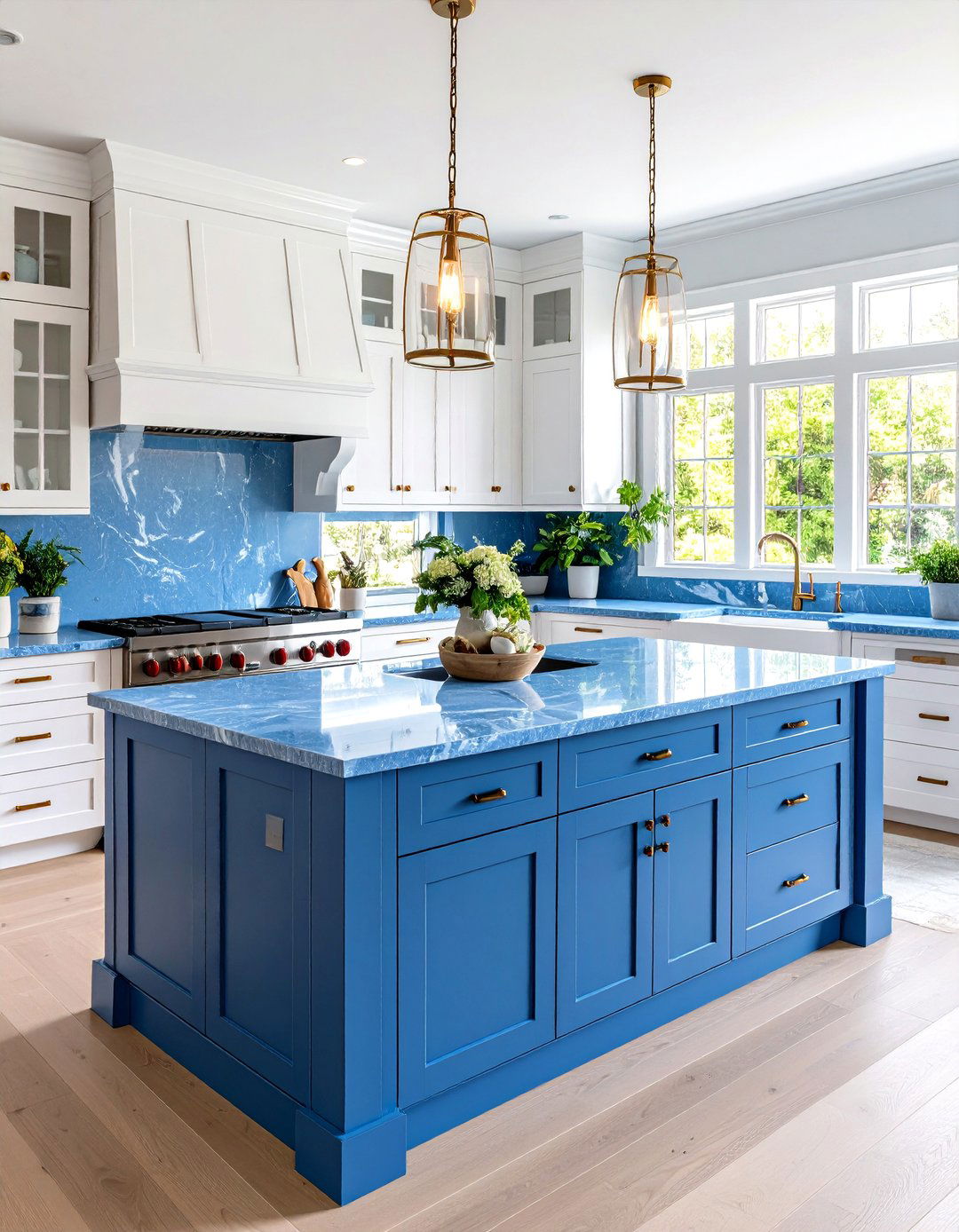
Select blue-gray quartz countertops that subtly reference stormy skies and calm seas while providing durable, low-maintenance work surfaces. Blue-gray tones bridge the gap between neutral and colorful, adding sophisticated coastal color without overwhelming the space. These engineered surfaces offer consistent patterning and superior durability compared to natural stone while maintaining an elegant, upscale appearance. The cool gray-blue tones complement both warm and cool accent colors, providing flexibility for seasonal decorating and changing accessories. Pair with white or cream cabinetry to let the countertop color take center stage, or combine with sage green or seafoam cabinets for a more dramatic coastal palette. The subtle color adds depth and sophistication while maintaining the calm, serene atmosphere that defines successful coastal kitchen design and makes these spaces feel like peaceful retreats.
19. Coastal Kitchen with Nautical Hardware and Fixtures
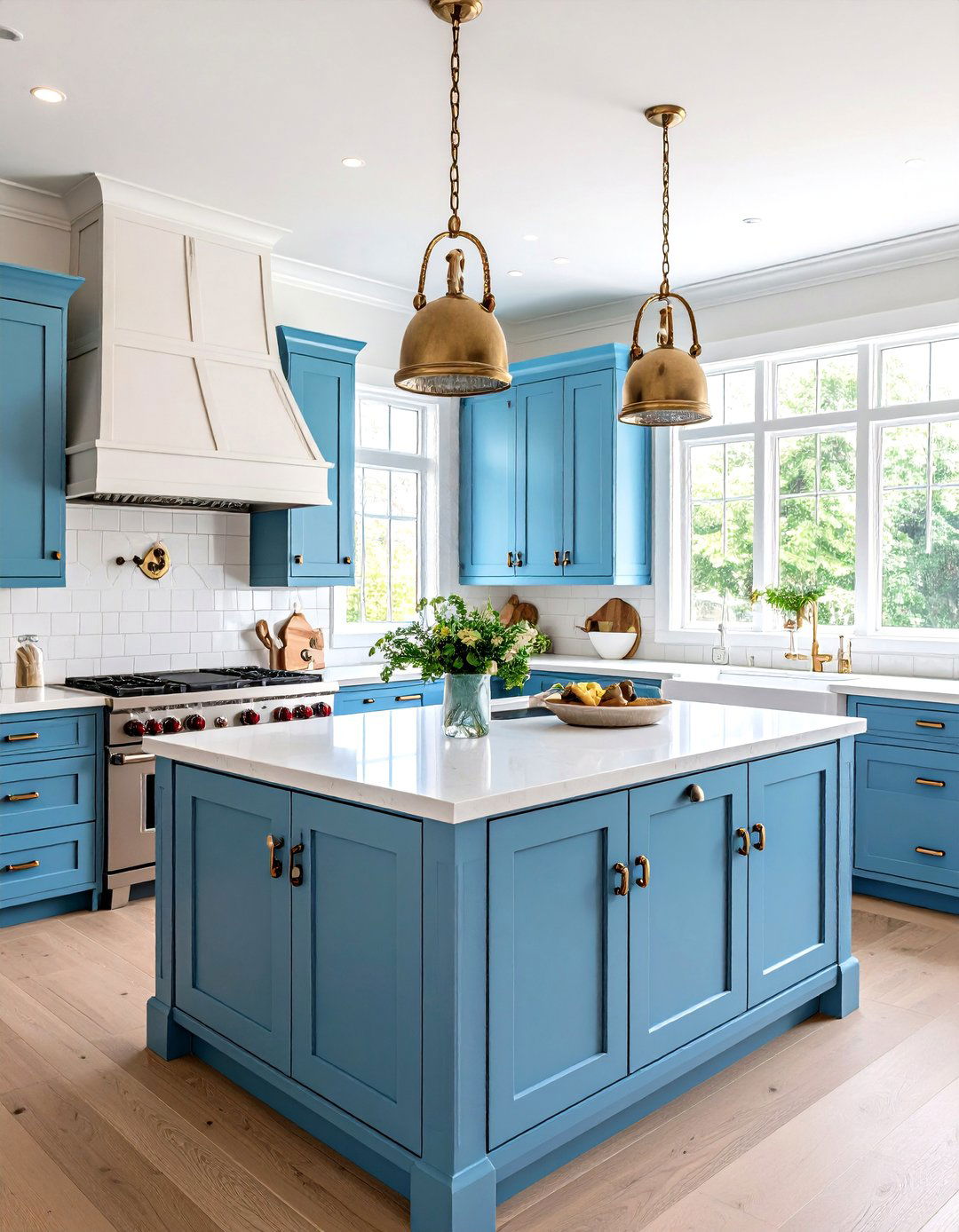
Complete your coastal kitchen with carefully chosen hardware and fixtures that reference maritime traditions without becoming overly themed. Select cabinet pulls and knobs with rope details, anchor motifs, or weathered metal finishes that add authentic coastal character. Choose faucets with brushed brass or aged bronze finishes that suggest weathered maritime metals. Brass and bronze tones add warmth to cool coastal color palettes while providing the kind of authentic detail that makes spaces feel carefully curated. Consider rope-wrapped drawer pulls, ship cleat-inspired hooks, or porthole-style cabinet details used sparingly for maximum impact. The key is selecting pieces that suggest rather than literally represent nautical elements, maintaining sophistication while adding personality. These finishing details should enhance rather than dominate the overall design, creating a cohesive coastal aesthetic that feels authentic and well-considered rather than obviously themed or commercial.
20. Coastal Kitchen with Beadboard Wainscoting Details
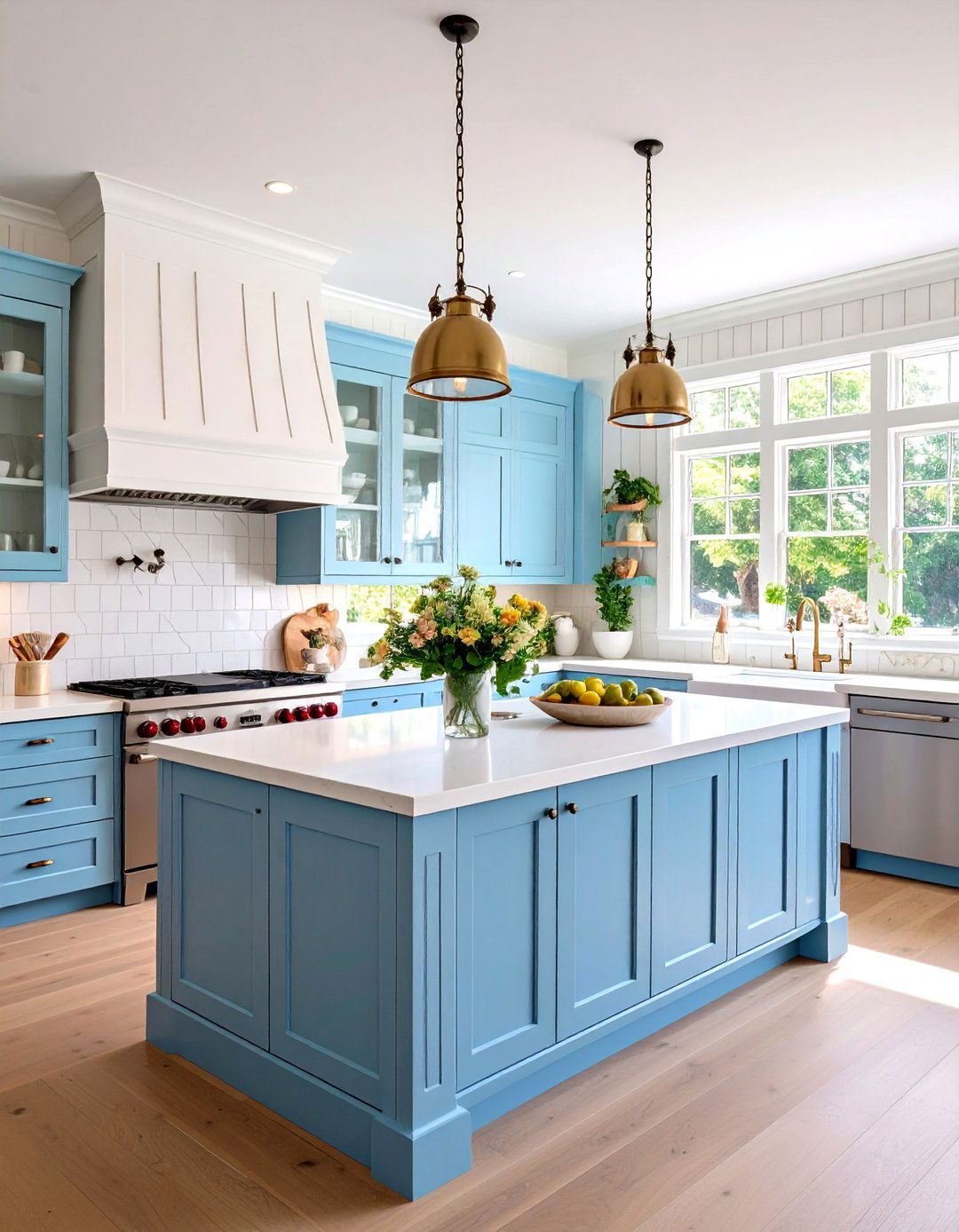
Finish your coastal kitchen with traditional beadboard wainscoting that references classic seaside architecture. Beadboard adds vertical texture and cottage-style charm while creating visual interest on lower wall areas. The vertical lines help make ceilings appear higher while adding authentic coastal character that feels both traditional and timeless. Paint the wainscoting in crisp white or soft coastal colors that complement your overall palette. This architectural detail brings to mind boardwalks and beach cottages while adding practical protection to high-traffic wall areas. Beadboard works particularly well in breakfast nooks, behind benches, or as a full wall treatment in casual dining areas. The classic detail adds personality and architectural interest while maintaining the clean, uncluttered lines essential to coastal design. Consider carrying the beadboard detail to other areas of the home for cohesive coastal character throughout your living spaces.
Conclusion:
Creating the perfect coastal kitchen involves balancing color, texture, and natural materials to capture the serene essence of seaside living. The most successful coastal kitchens combine light, airy color palettes with natural materials and sophisticated finishes that feel both relaxed and refined. Whether incorporating navy blue accents, natural fiber lighting, or weathered wood details, each element should contribute to the overall sense of calm and connection to the sea. Remember that authentic coastal design is about creating a feeling rather than following a literal theme, allowing your kitchen to serve as a peaceful retreat that embodies the timeless appeal of coastal living.


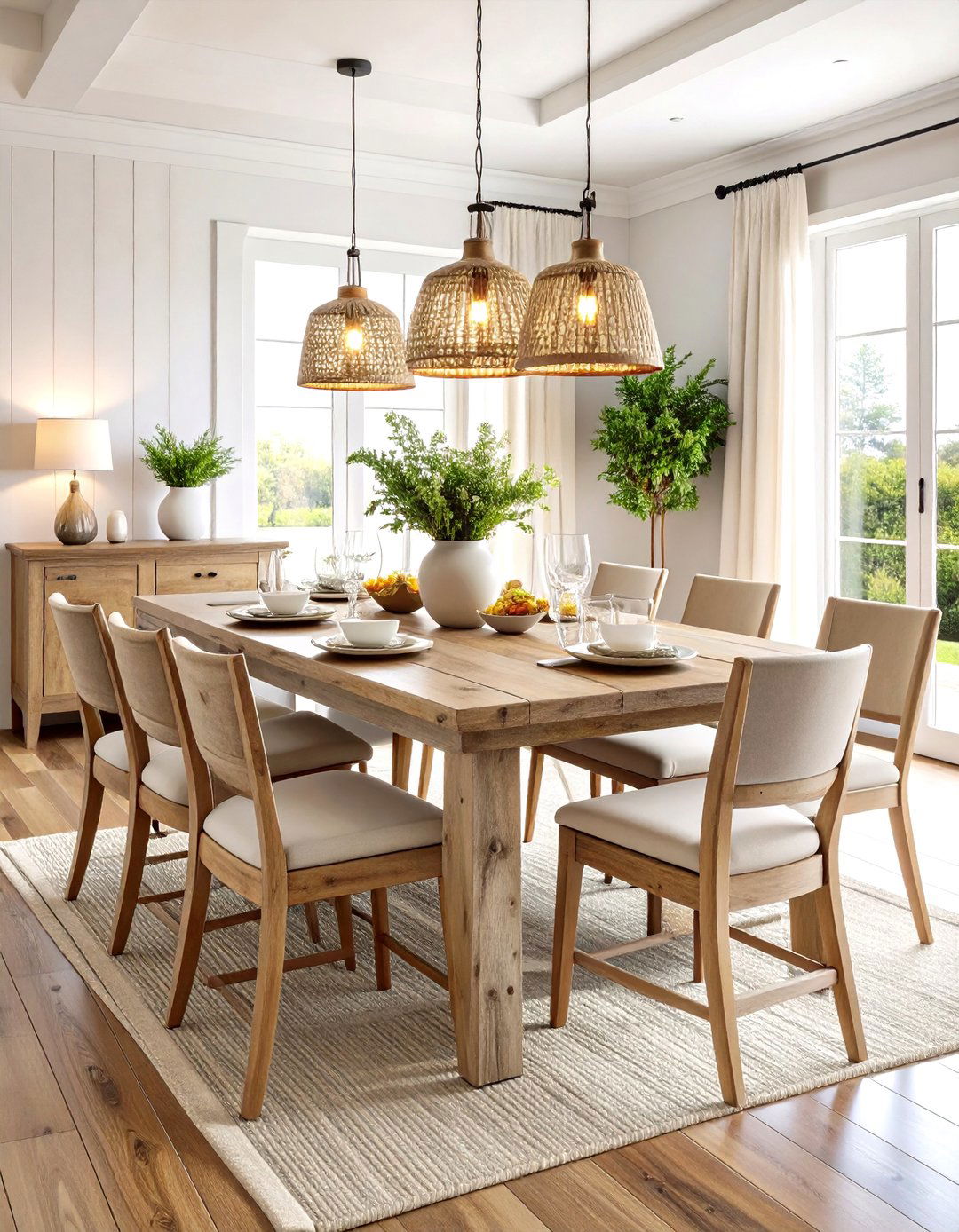
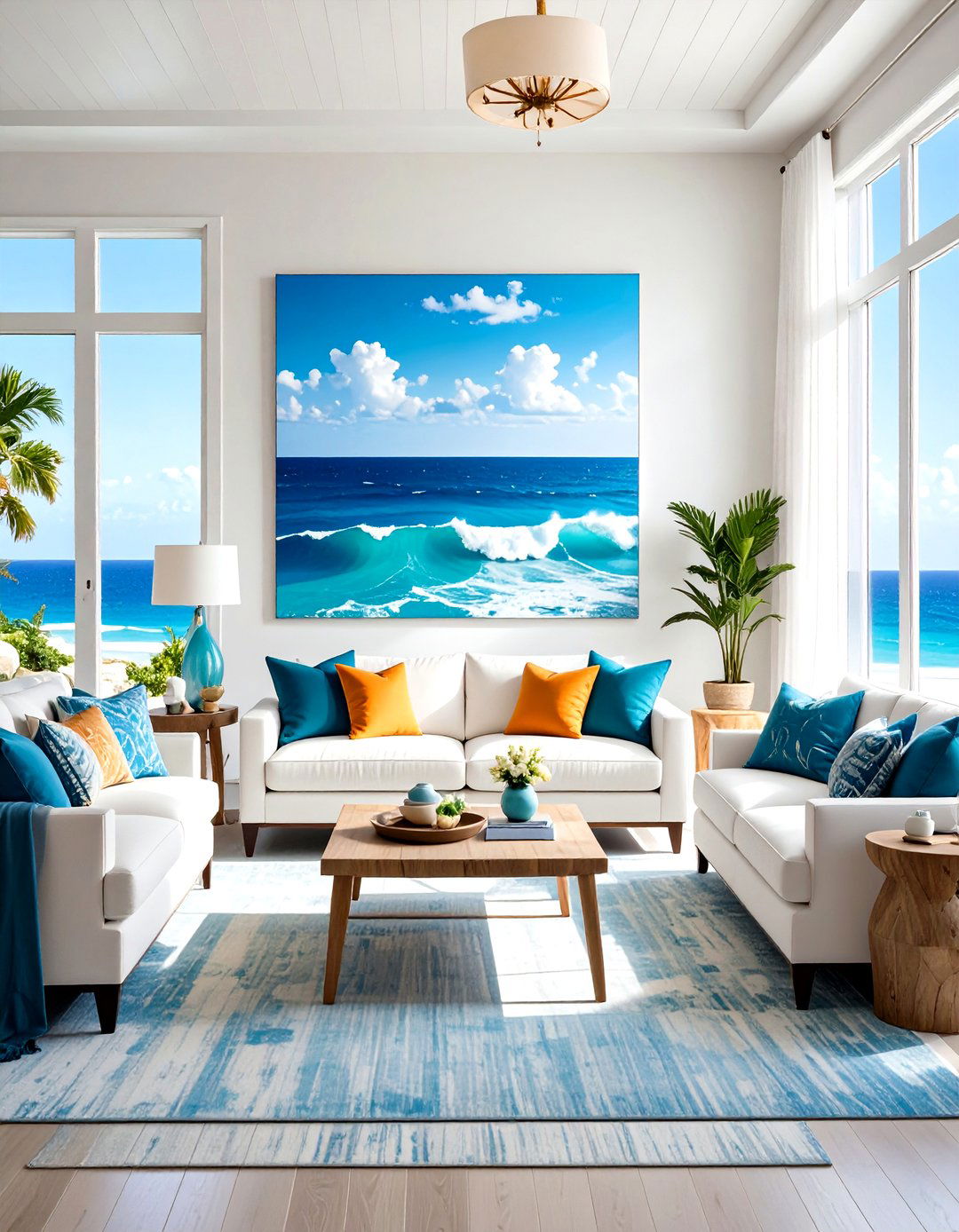

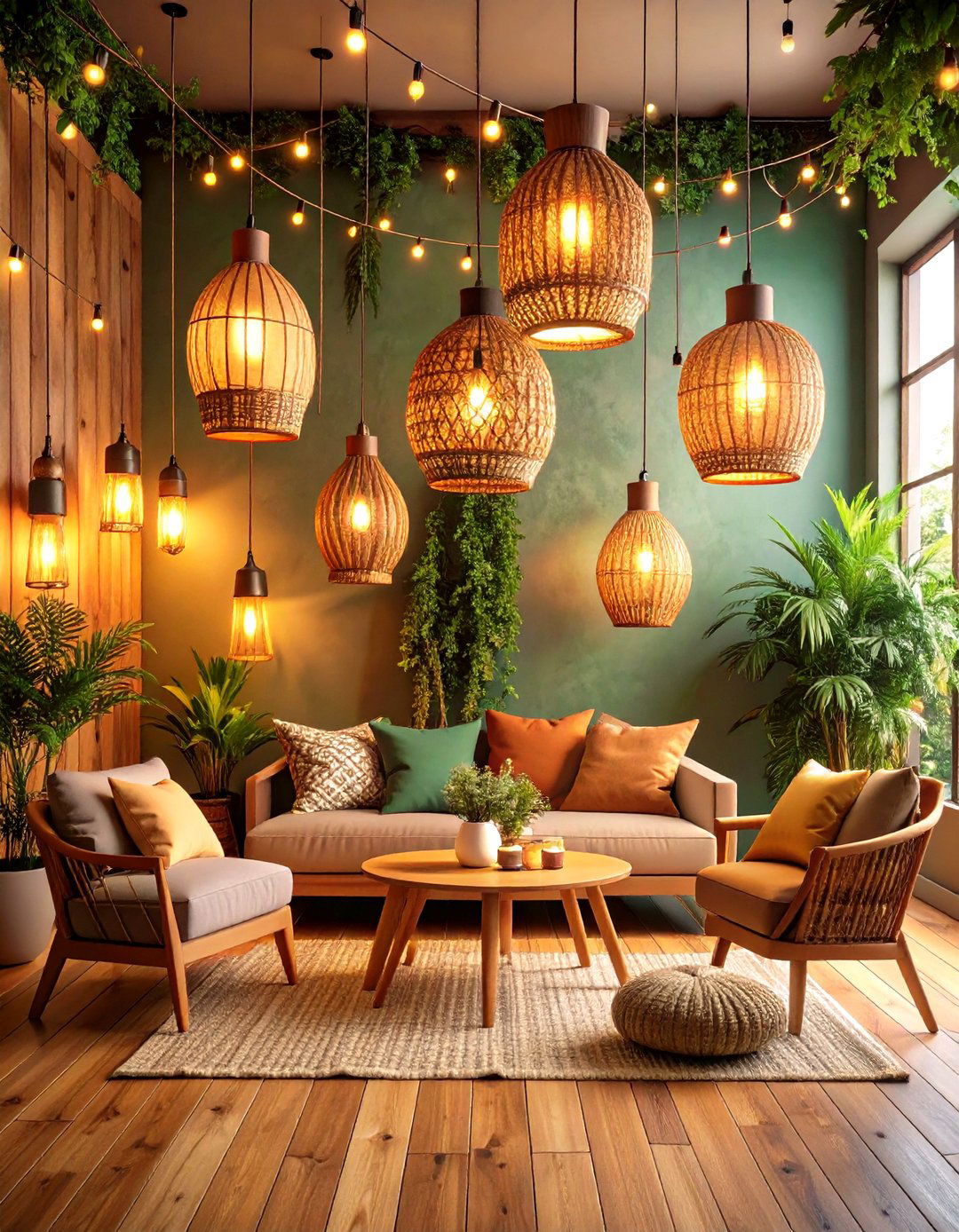
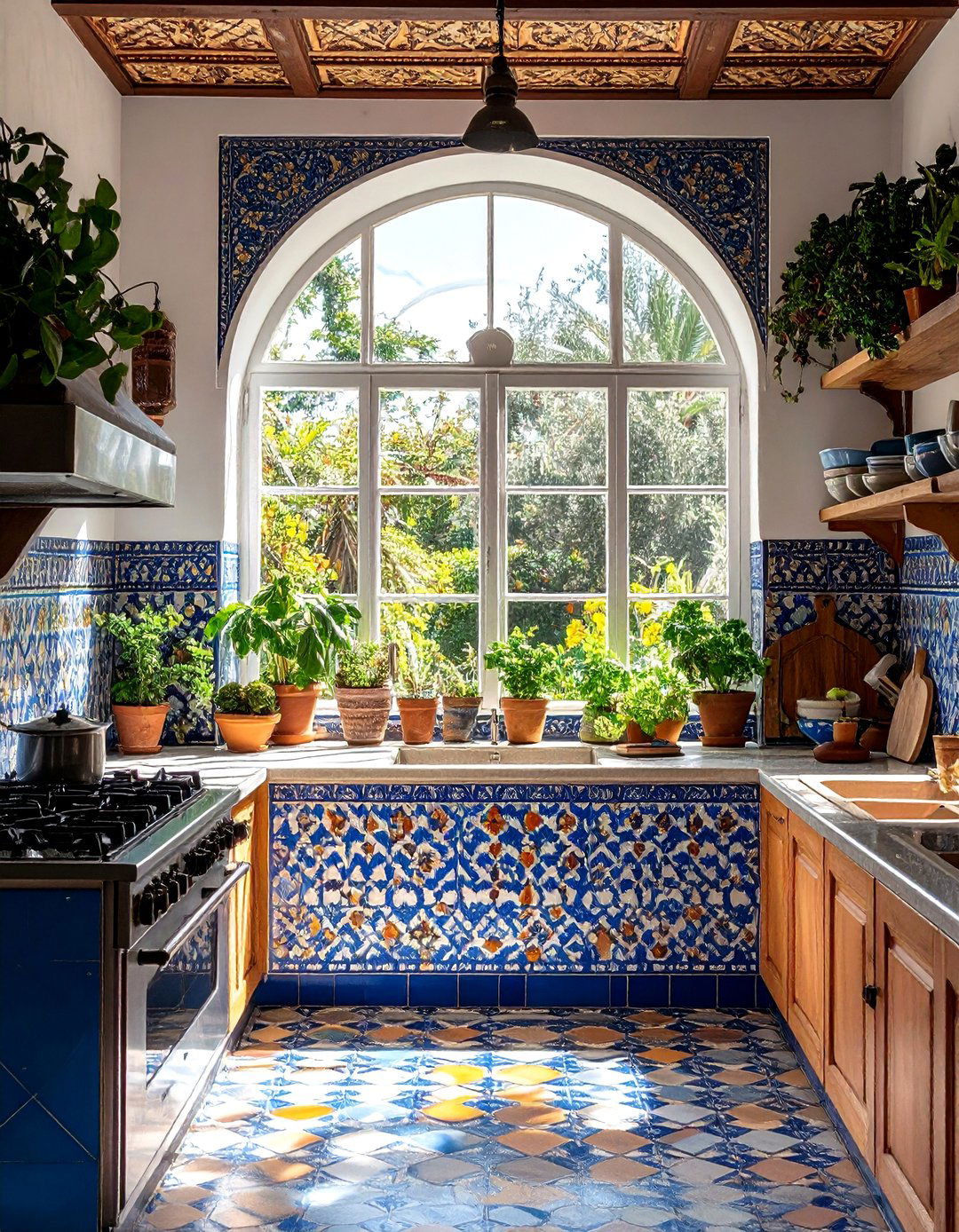
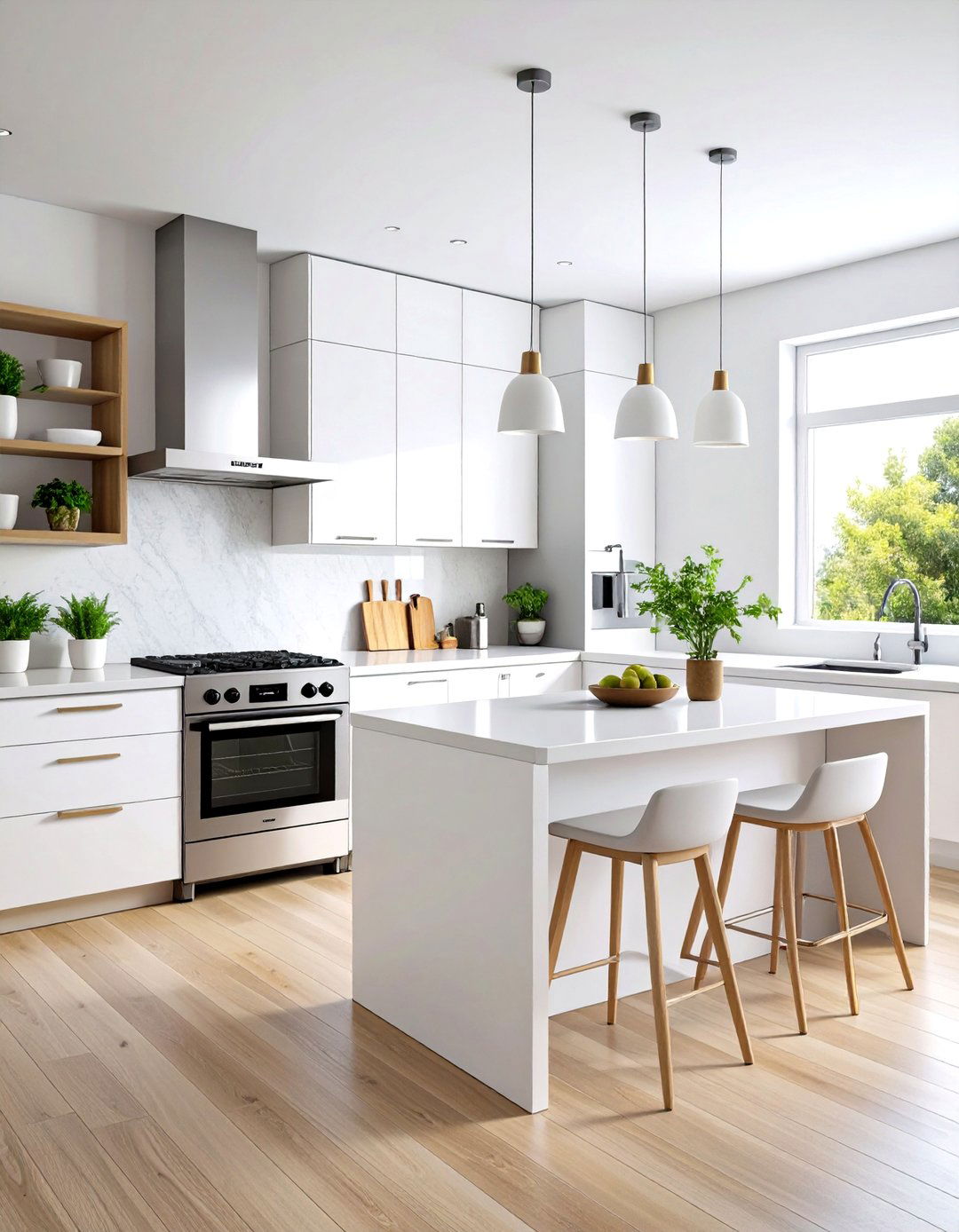

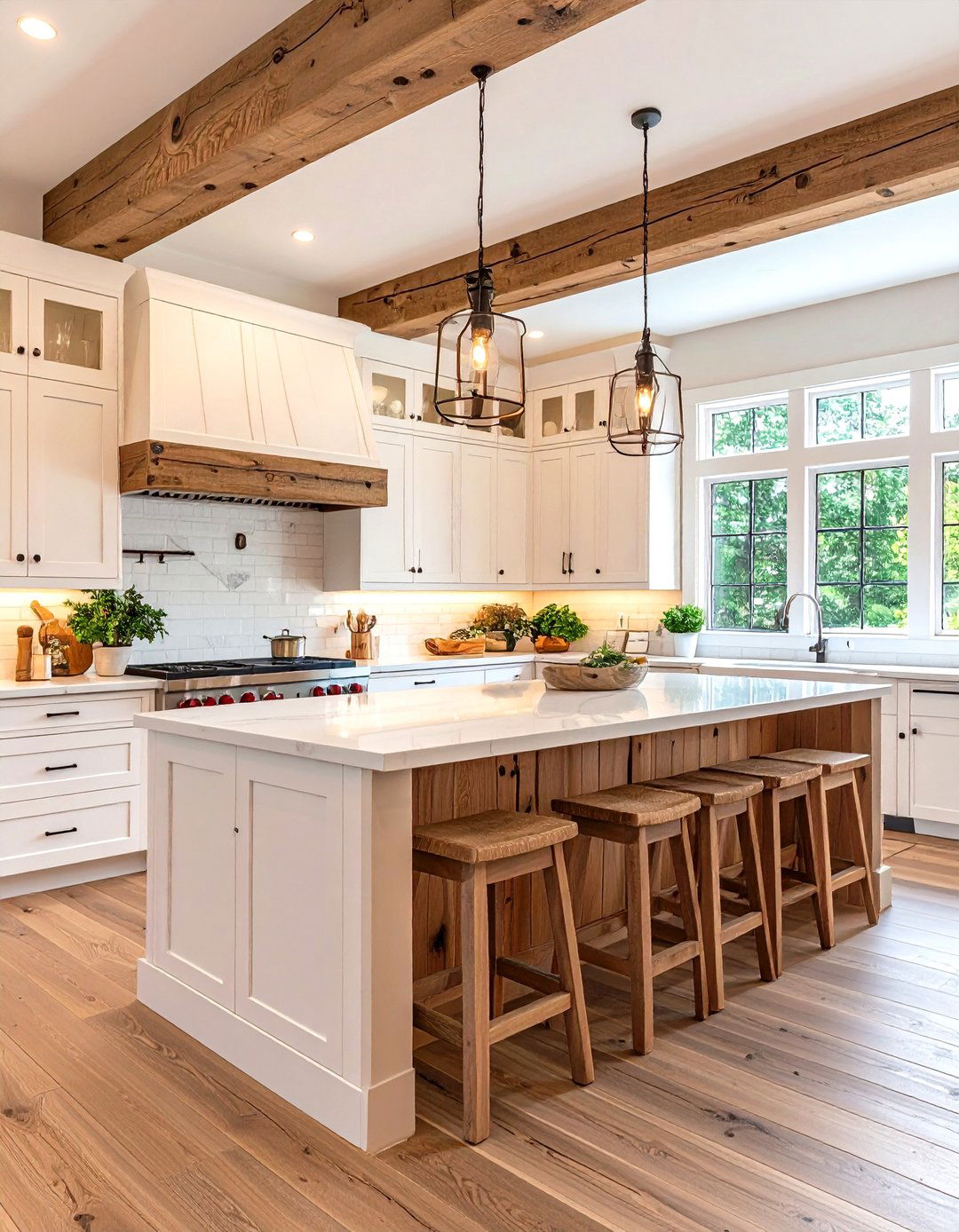
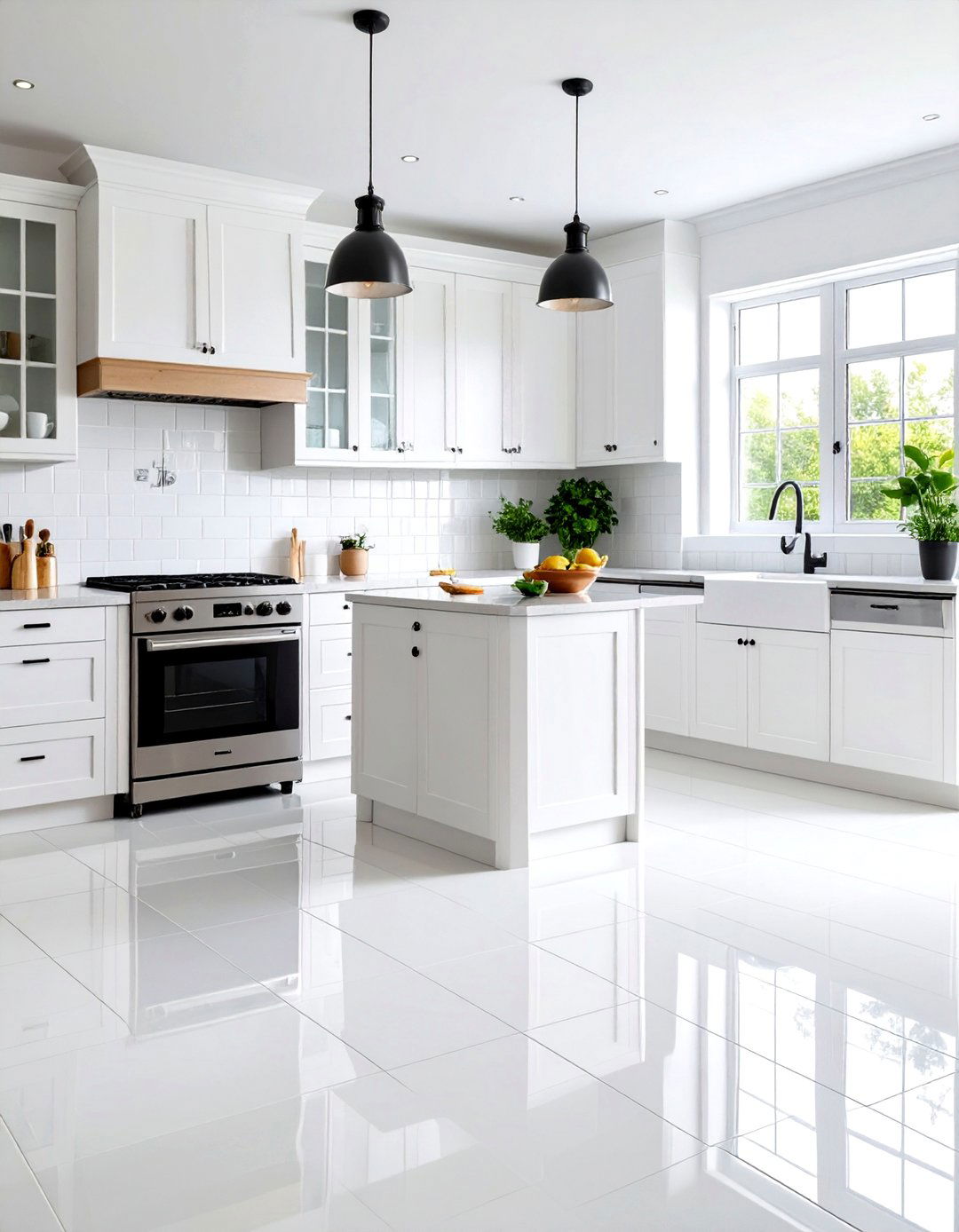
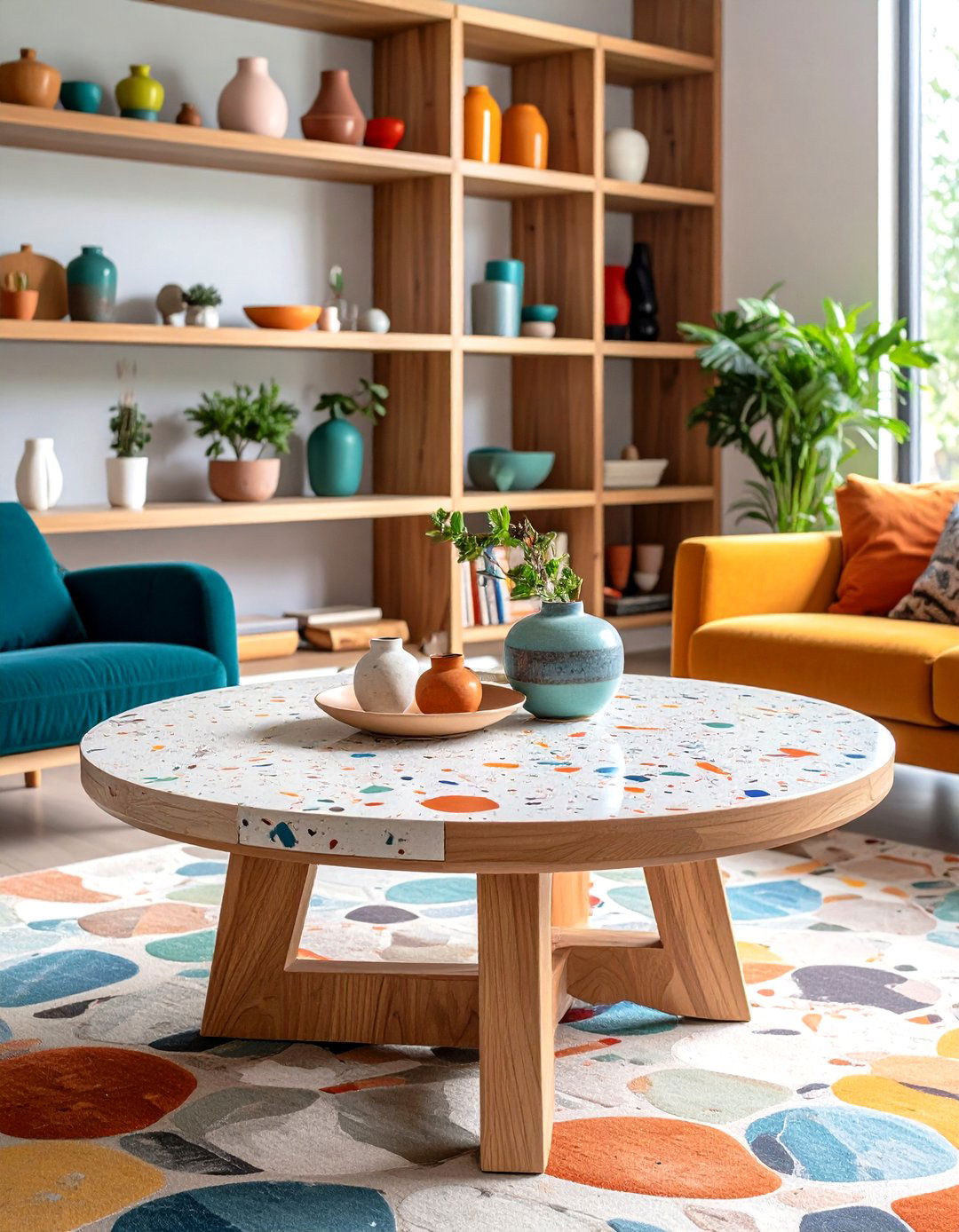

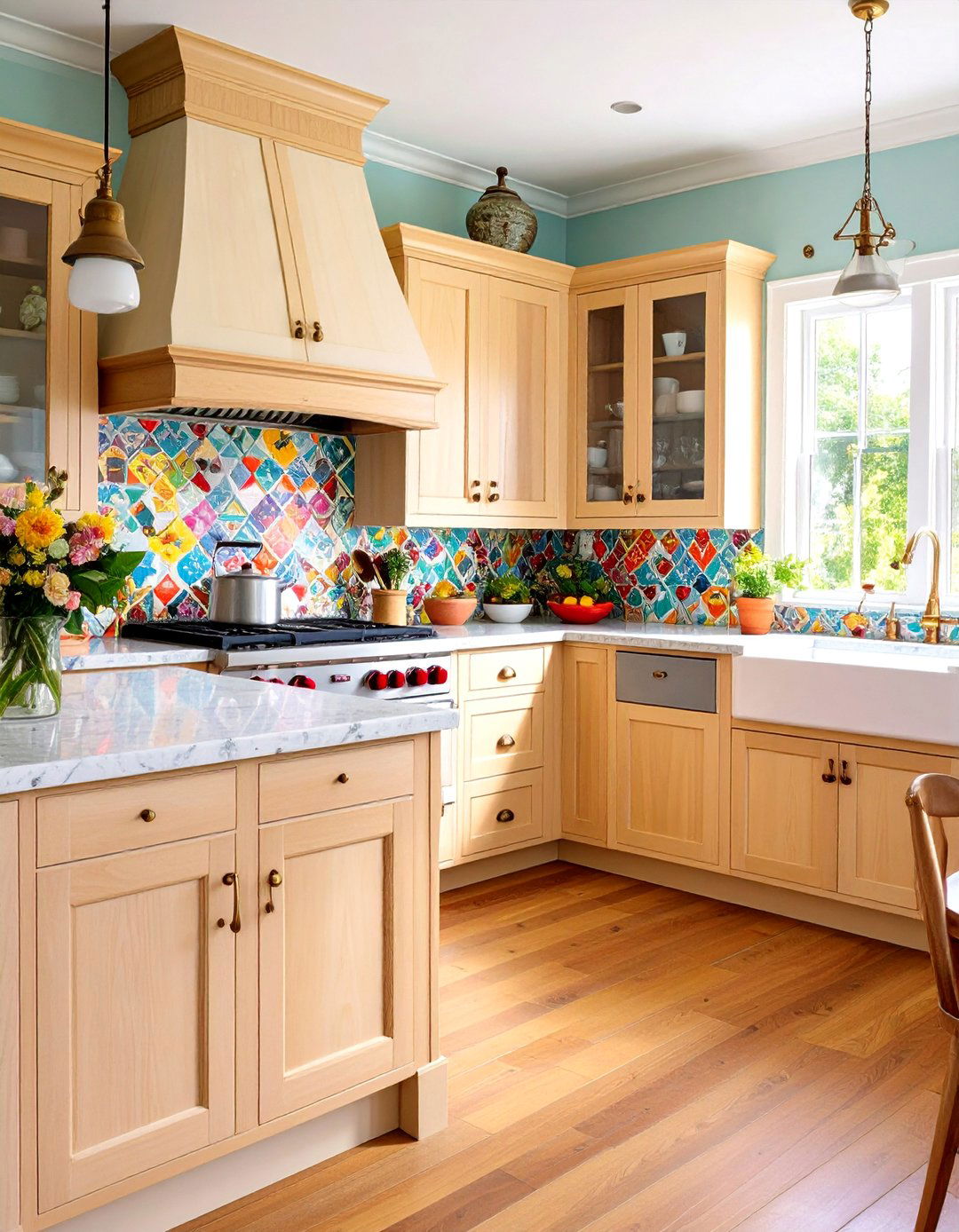
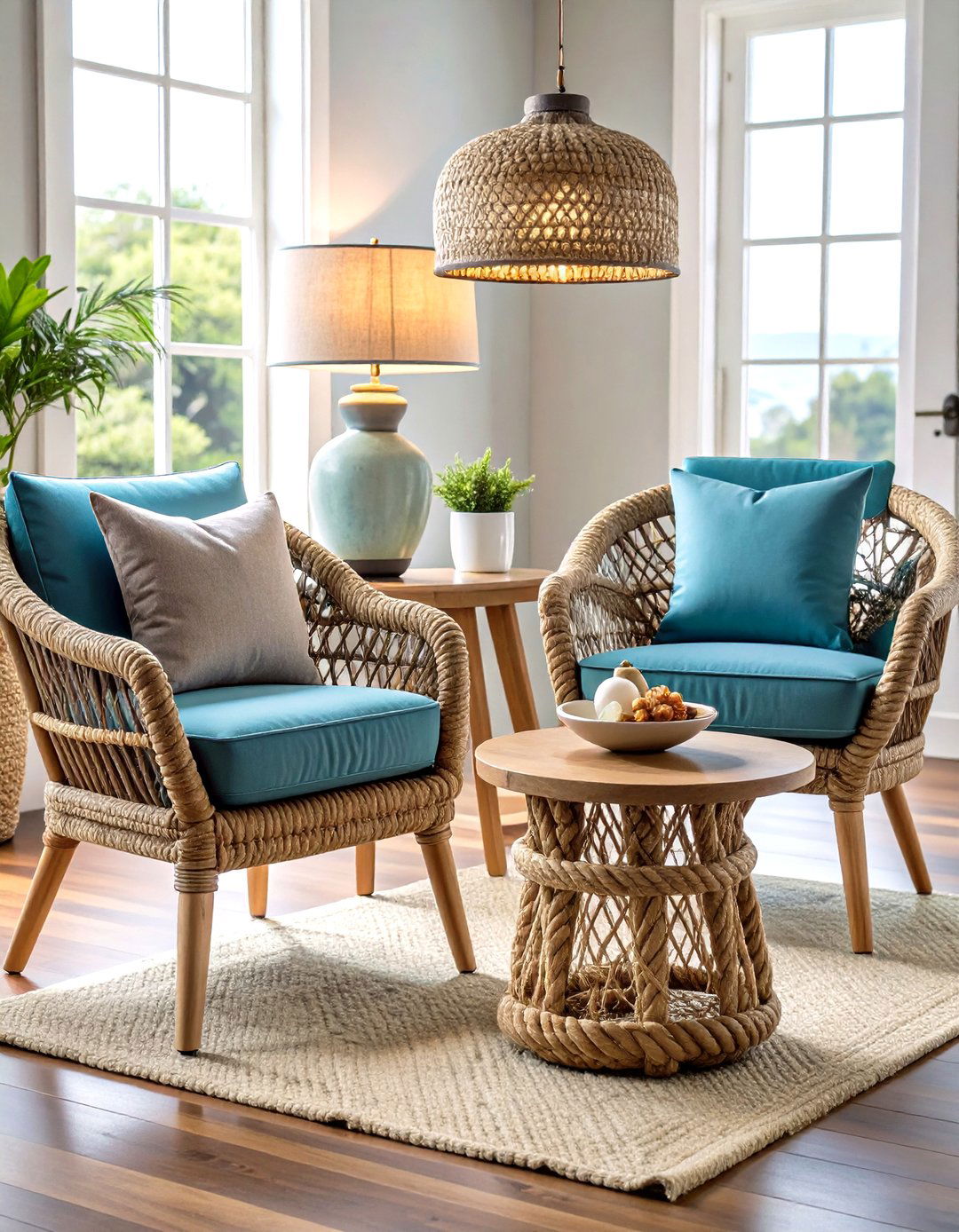
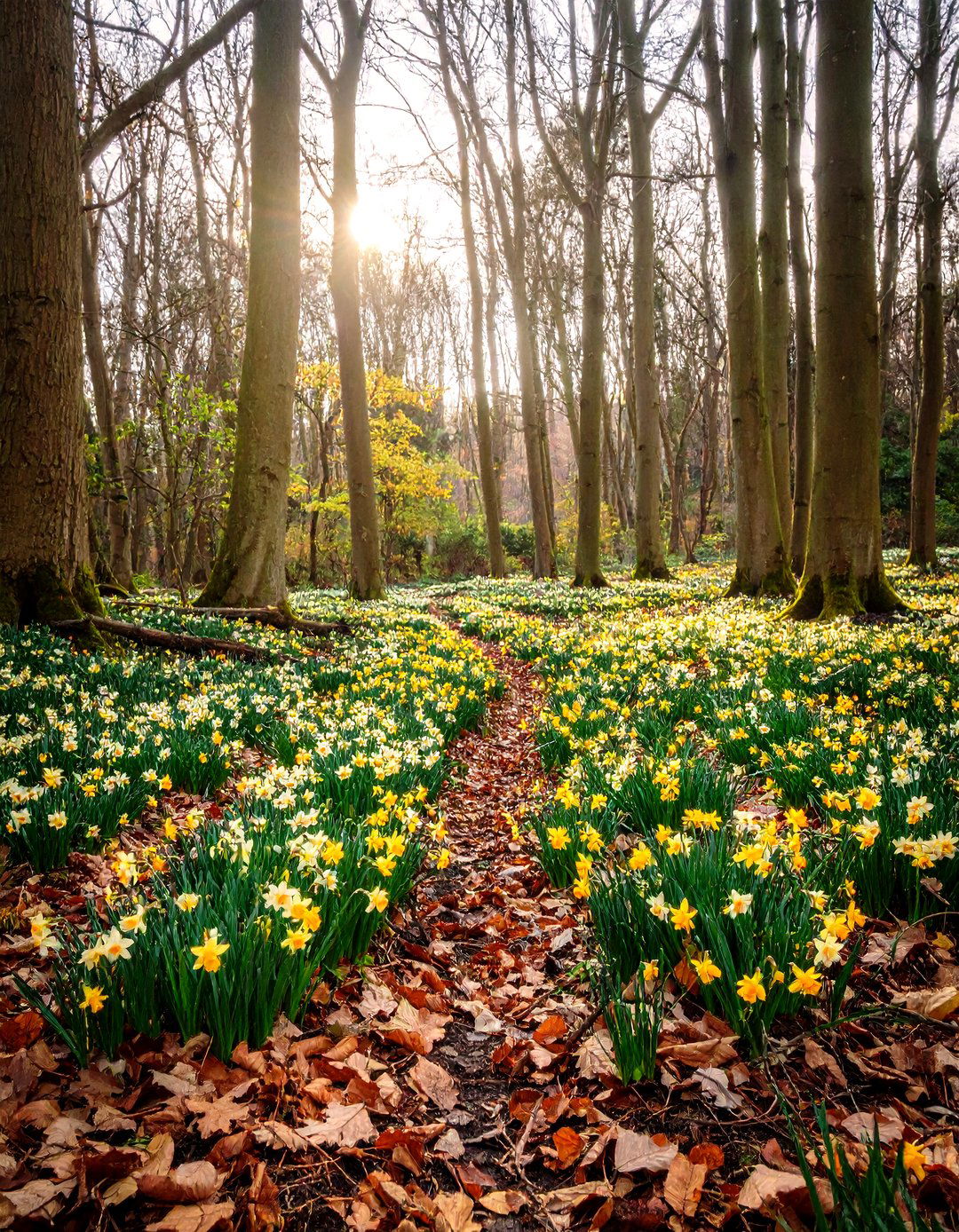
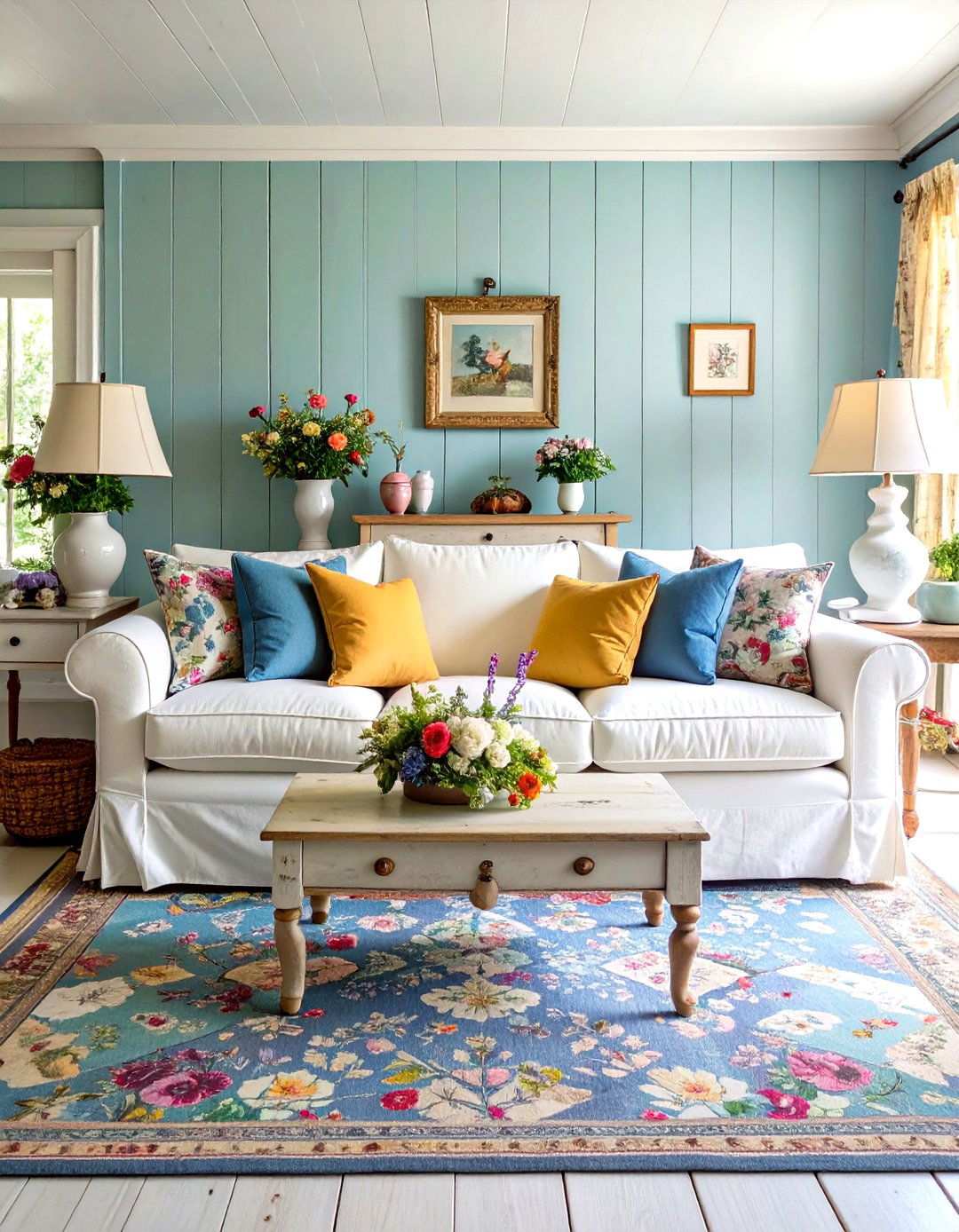
Leave a Reply